Monday, August 14 2023
Final round of voting is here and I made it this far - If you liked the cover of my book, Believing in Mac: The Camerons of Tide’s Way (Book 7), won't you please give it another vote in the Cover of the Month contest on AllAuthor.com! https://allauthor.com/cover-of-the-month/16087/
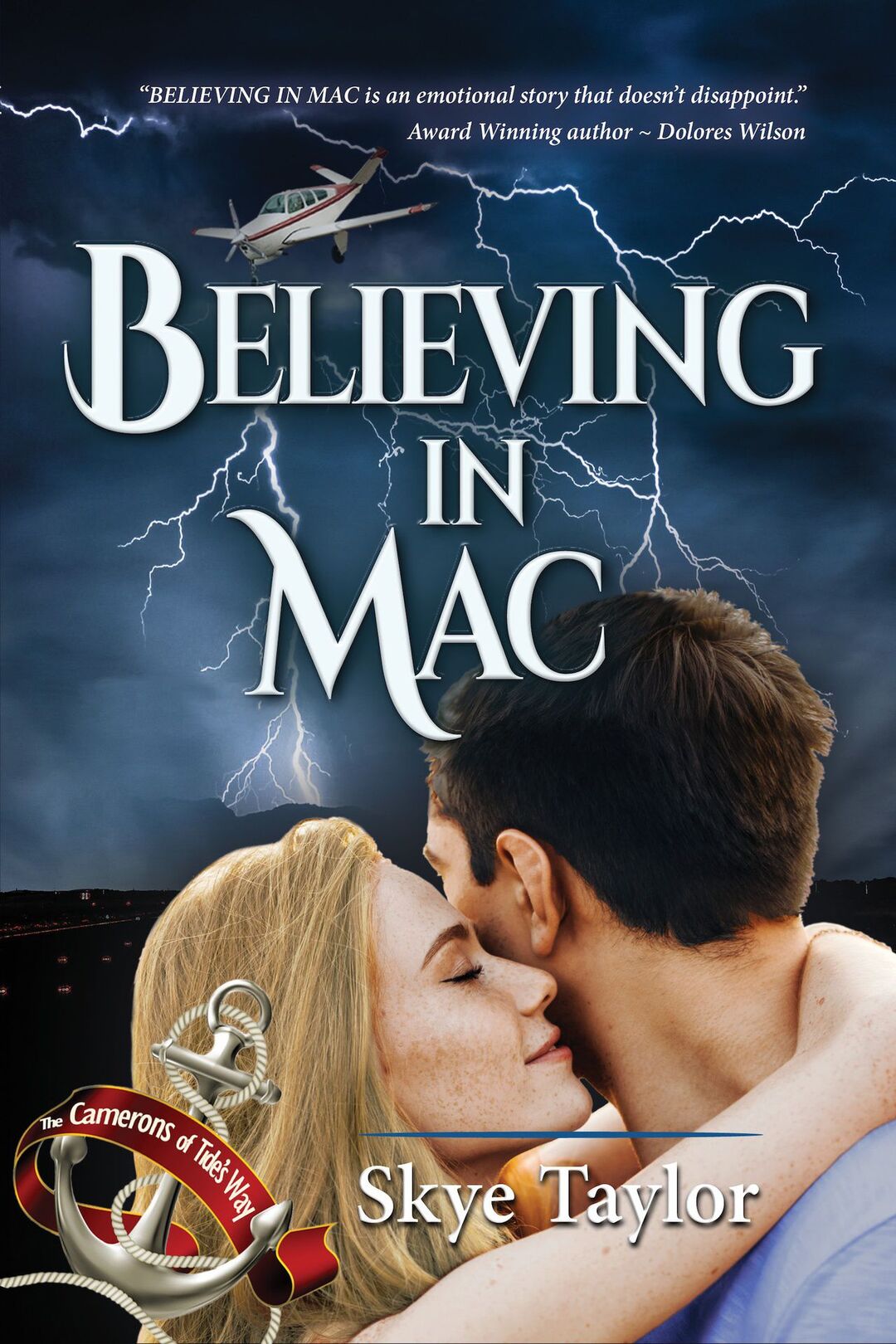
Show me love and vote for my Book Cover at the #CoverOfTheMonth contest. https://allauthor.com/cover-of-the-month/16087/
Monday, July 31 2023
They say not to judge a book by its cover but I need you to do just that. If you liked the cover of my book, Believing in Mac: The Camerons of Tide’s Way (Book 7), please vote for it for the Cover of the Month contest on AllAuthor.com!
https://allauthor.com/cover-of-the-month/16087/ 
Saturday, July 22 2023
This month our Round Robin Bloggers are going to discuss how important is Character Arc to our stories and how does it tie into the plot or story arc? Do we usually give some time and story to character arcs for secondary characters?
XX
There are exceptions to every rule. Jack Reacher, for one, seems to have pretty much no character arc. Sure, he has flaws, but they play into the plot of the suspense and action. Sherlock Holmes comes to mind as another pretty much unchanging character as is Jessica Fletcher in the Murder She Wrote TV series of a few years back. In these books and shows, the plot or story arc is what carries the action and we know little or nothing of the characters outside of the current plot.
XX
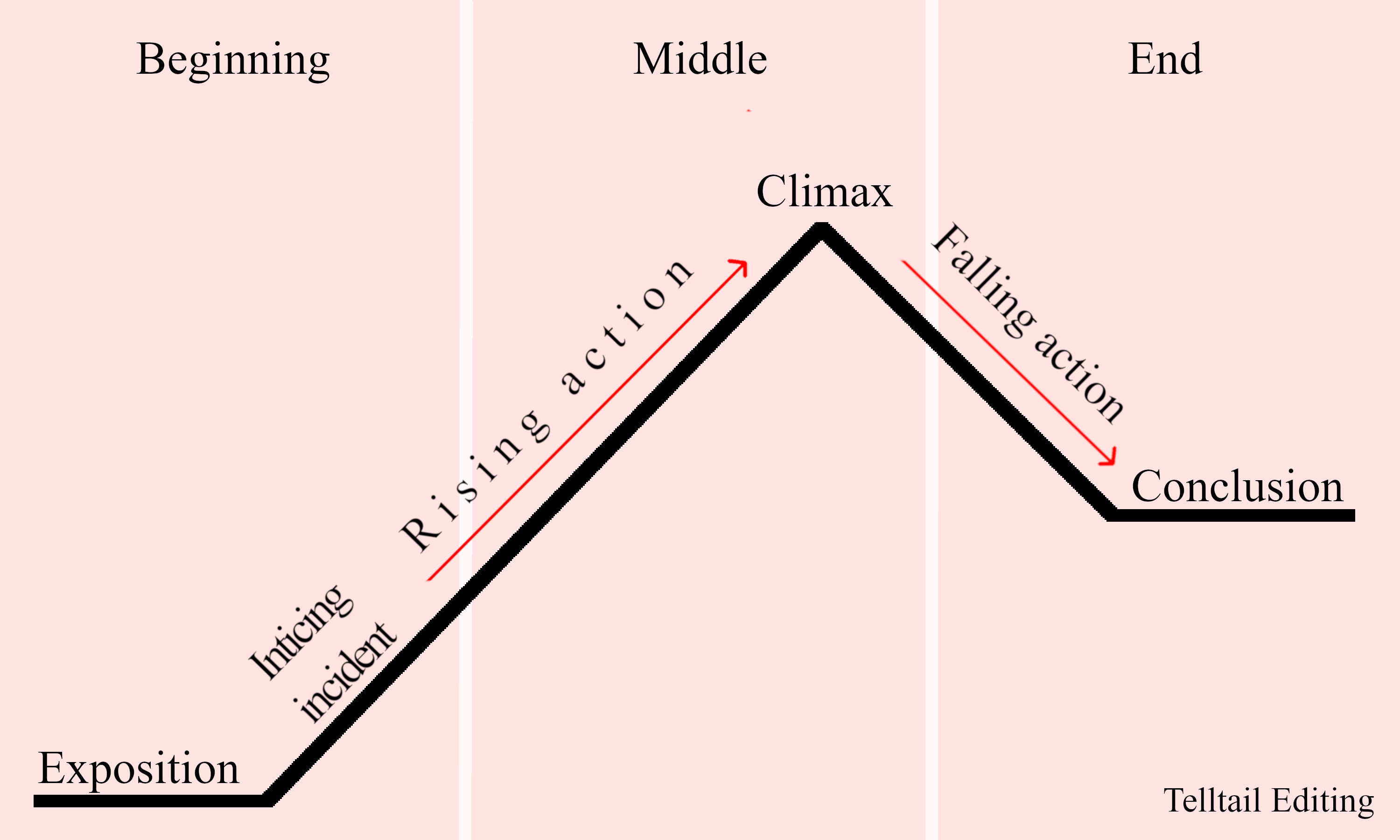 Story arc has five dramatic stages: exposition, rising action, climax, falling action, and resolution. Or to shorten that, a beginning, middle and end. The beginning is when the problem is introduced. Maybe it’s a dead body. Maybe it’s a kidnapped child, or a terrorist threat. But whatever it is, it grabs the reader’s attention by the obvious need to be dealt with, sooner rather than later. And the characters in this kind of story, leap into action to do just that. Finding the cause, or the culprit, figuring out what kind of terrorist attack is brewing and the who/what/why and where is the meat of the story. But without the satisfying ending: The murderer is caught, the threat thwarted and the child rescued, none of us would tune in again, or purchase another book by that author. Story arc has five dramatic stages: exposition, rising action, climax, falling action, and resolution. Or to shorten that, a beginning, middle and end. The beginning is when the problem is introduced. Maybe it’s a dead body. Maybe it’s a kidnapped child, or a terrorist threat. But whatever it is, it grabs the reader’s attention by the obvious need to be dealt with, sooner rather than later. And the characters in this kind of story, leap into action to do just that. Finding the cause, or the culprit, figuring out what kind of terrorist attack is brewing and the who/what/why and where is the meat of the story. But without the satisfying ending: The murderer is caught, the threat thwarted and the child rescued, none of us would tune in again, or purchase another book by that author.
XX
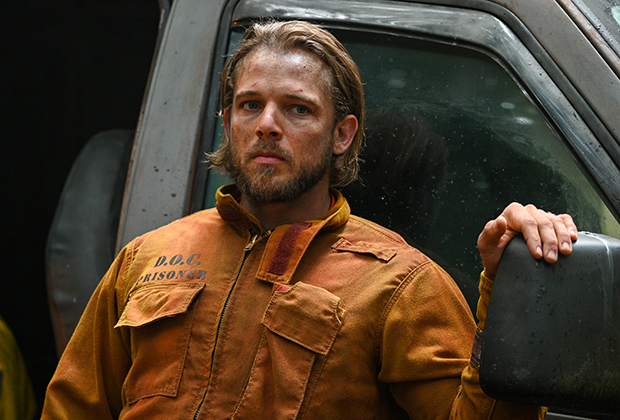 But, in most of today’s TV action series and police dramas, the cast of characters all have personal lives that intersect and impact the telling of the main story and those personal character arcs add depth and reality to the stories. Fire Country, for instance, features a man on early parole as a volunteer firefighter. There is the chief and his wife and the rest of the men and women on the squad and each of them have a character arc that evolves over the course of the series. Blue Bloods is based on a NY family of cops, a lawyer (Asst DA), a nurse, and their kids and other extended family. Again, all of those characters have a personal character arc that adds interest and reality to the main drama of a cataclysmic fire or the day to day life of law enforcement in NYC. Back when my dad But, in most of today’s TV action series and police dramas, the cast of characters all have personal lives that intersect and impact the telling of the main story and those personal character arcs add depth and reality to the stories. Fire Country, for instance, features a man on early parole as a volunteer firefighter. There is the chief and his wife and the rest of the men and women on the squad and each of them have a character arc that evolves over the course of the series. Blue Bloods is based on a NY family of cops, a lawyer (Asst DA), a nurse, and their kids and other extended family. Again, all of those characters have a personal character arc that adds interest and reality to the main drama of a cataclysmic fire or the day to day life of law enforcement in NYC. Back when my dad  religiously watched Perry Mason, a lawyer who always got his client off (and all his clients were actually innocent) we knew nothing about Mr. Mason the man. Was he married? Have kids? Aging parents? Did he play poker? Drink? Who knew? Today’s TV lawyers all have a life that the writers skillfully incorporate into the theme of the main story. For series that span several seasons, there are love affairs and marriage, kids are born or going off to college. Some characters even struggle with drug or alcohol addiction, gender issues and other hot topics of the day. But all those individual character arcs add compelling interest in the series and keeps viewers tuning in every week and readers eager to buy the next book as soon as it comes out. religiously watched Perry Mason, a lawyer who always got his client off (and all his clients were actually innocent) we knew nothing about Mr. Mason the man. Was he married? Have kids? Aging parents? Did he play poker? Drink? Who knew? Today’s TV lawyers all have a life that the writers skillfully incorporate into the theme of the main story. For series that span several seasons, there are love affairs and marriage, kids are born or going off to college. Some characters even struggle with drug or alcohol addiction, gender issues and other hot topics of the day. But all those individual character arcs add compelling interest in the series and keeps viewers tuning in every week and readers eager to buy the next book as soon as it comes out.
XX
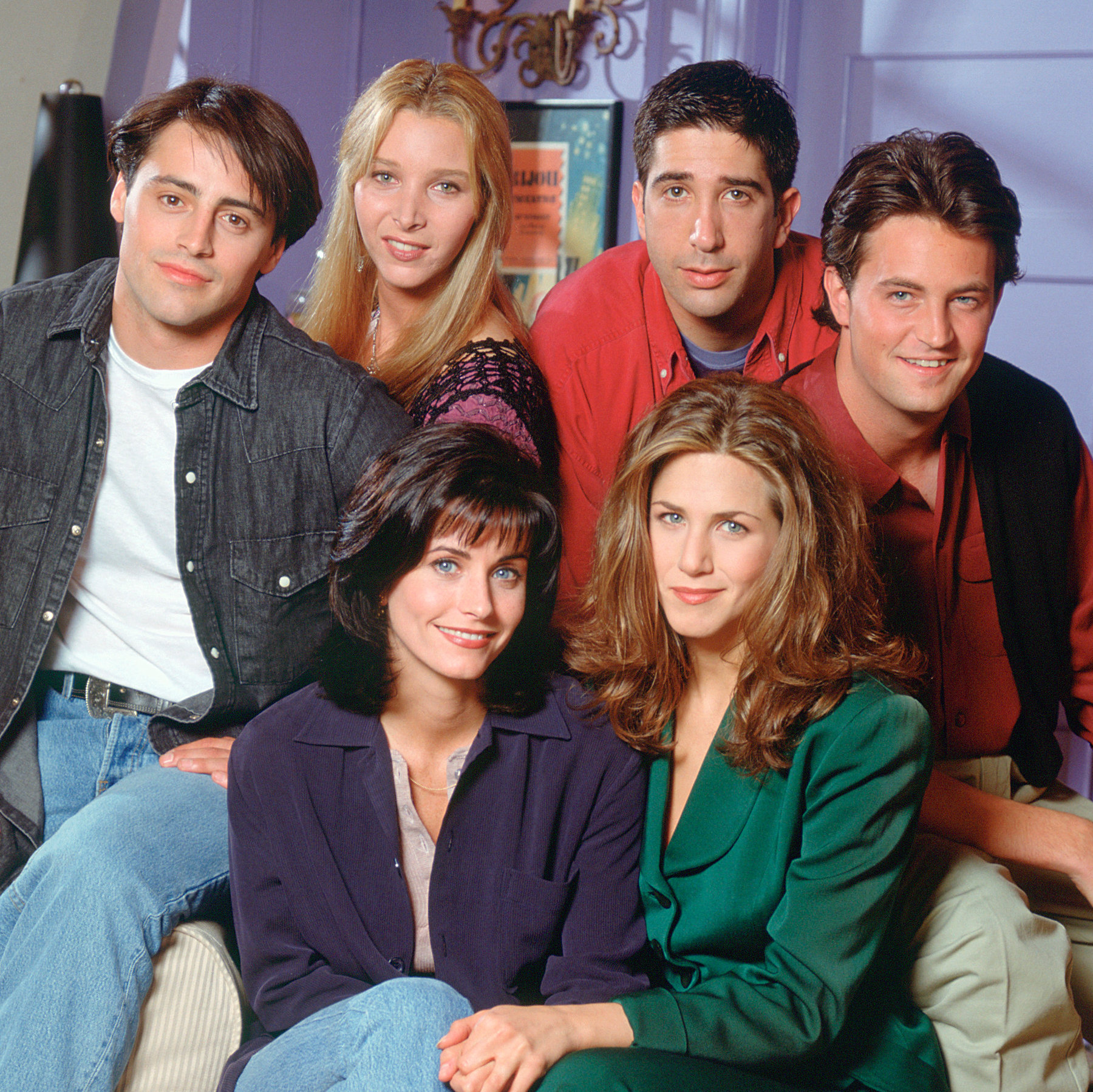 But then there are the stories that depend entirely on character arc. Romances. Family dramas. Women’s Fiction and others. There is a story arc in all of these books, too, but it is the character arc that makes or breaks the book. What do the characters want, why, and what’s stopping them? In the TV comedy series, Friends, or Big Bang Theory, each week was another view into the lives of these individual characters and their jobs, free time etc, but it was their personal growth that carried the series from one year to the next. Romances happened, jobs changed, neighbors came and went and every time the characters involved had to grow or adapt to the new realities. Their character arcs were as important to the success of the series as the comedic presentation. But then there are the stories that depend entirely on character arc. Romances. Family dramas. Women’s Fiction and others. There is a story arc in all of these books, too, but it is the character arc that makes or breaks the book. What do the characters want, why, and what’s stopping them? In the TV comedy series, Friends, or Big Bang Theory, each week was another view into the lives of these individual characters and their jobs, free time etc, but it was their personal growth that carried the series from one year to the next. Romances happened, jobs changed, neighbors came and went and every time the characters involved had to grow or adapt to the new realities. Their character arcs were as important to the success of the series as the comedic presentation.
XX
 But in our novels, this is even more important. Our main characters must grow and change. They have to fight their individual battles and come out stronger, smarter, or better able to adapt. For those of you who never read the initial book, Outlander, Clair Beauchamp, a WWII nurse went through the stones and ended up in the mid 1700s. She was faced with a very different world than anything she had ever experienced. Her life was precarious for so many reasons, one being her modern day knowledge of medicine that could get her branded as a witch, to say nothing of the fact she was a stranger in that time and place with no family or friends. Her character arc included learning how to live in those less comfortable times and learning to live with the fact that she had left a husband she loved in the future and was further troubled by falling in love with another man in her new time. At the start, she wanted desperately to go back to her own time, but as that became less and less likely, and her love for Jamie grew, she adapted to not getting her initial desire, but finding peace and meaning in her new life. But in our novels, this is even more important. Our main characters must grow and change. They have to fight their individual battles and come out stronger, smarter, or better able to adapt. For those of you who never read the initial book, Outlander, Clair Beauchamp, a WWII nurse went through the stones and ended up in the mid 1700s. She was faced with a very different world than anything she had ever experienced. Her life was precarious for so many reasons, one being her modern day knowledge of medicine that could get her branded as a witch, to say nothing of the fact she was a stranger in that time and place with no family or friends. Her character arc included learning how to live in those less comfortable times and learning to live with the fact that she had left a husband she loved in the future and was further troubled by falling in love with another man in her new time. At the start, she wanted desperately to go back to her own time, but as that became less and less likely, and her love for Jamie grew, she adapted to not getting her initial desire, but finding peace and meaning in her new life.
XX
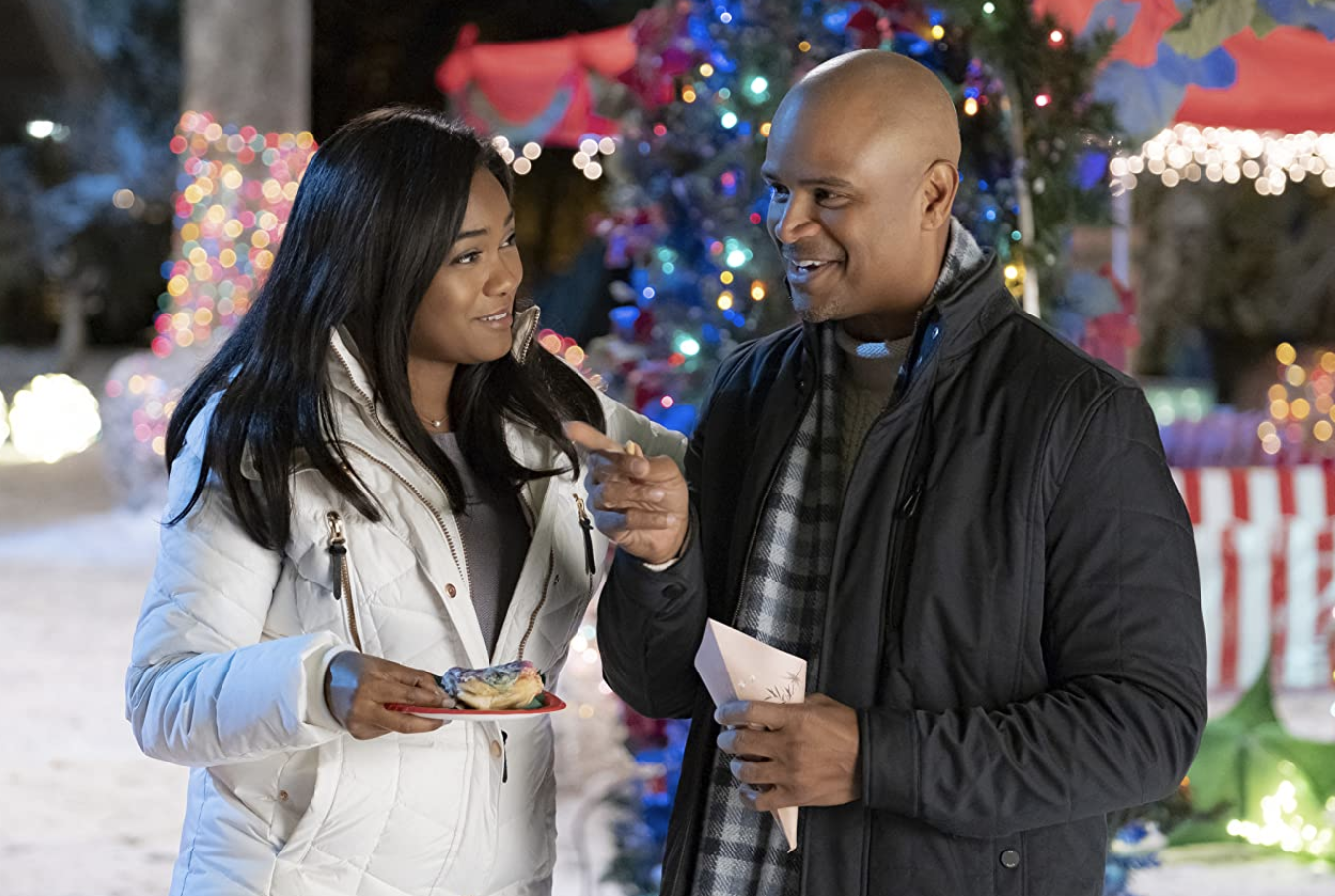 In contemporary romances there are two character arcs: the hero and the heroine. Each has something they want, often in opposition to each other. If you’ve ever watched the Hallmark channel you’ve probably had your fill of women who left home the moment they graduated high school, turned their backs on family and the boy they loved and planned never to come back and yet….here they are back in their home town, usually quaint while they were living the busy life in the city. First thing they realize is their old love is still here and usually not attached for one reason or another and all the old feelings are still there under the skin. But there’s history to be dealt with. The abandonment, or the belief that the other never cared as much as the hero or heroine once thought. Sometimes the story conflict is that either the hero or the heroine has been sent to purchase a property for the purpose of creating some grand new modern enterprise, but the other half of the duo is the current owner and it’s a family property or one with so much history the entire town is against it. Romances always have a happy ever after so that character arc includes learning to appreciate what had been left behind, what is of value now and how to compromise. In contemporary romances there are two character arcs: the hero and the heroine. Each has something they want, often in opposition to each other. If you’ve ever watched the Hallmark channel you’ve probably had your fill of women who left home the moment they graduated high school, turned their backs on family and the boy they loved and planned never to come back and yet….here they are back in their home town, usually quaint while they were living the busy life in the city. First thing they realize is their old love is still here and usually not attached for one reason or another and all the old feelings are still there under the skin. But there’s history to be dealt with. The abandonment, or the belief that the other never cared as much as the hero or heroine once thought. Sometimes the story conflict is that either the hero or the heroine has been sent to purchase a property for the purpose of creating some grand new modern enterprise, but the other half of the duo is the current owner and it’s a family property or one with so much history the entire town is against it. Romances always have a happy ever after so that character arc includes learning to appreciate what had been left behind, what is of value now and how to compromise.
XX
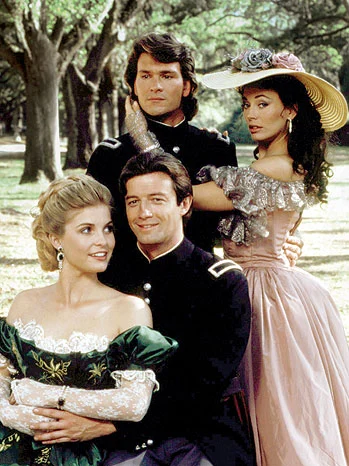 In a family drama, often there is no happy ever after, but the character arc is still of paramount importance. Think of all the family dramas you might have read or watched over the years. Dallas on TV or the Kent Family Chronicles by John Jakes. Over the course of those stories there were good times and bad, war and peace, love and loss, joy and grief. But it was how the various characters learned to cope, to grow and deal with the vicissitudes of life that made those stories compelling. Sometimes the characters flourished through desire and the hard work required to succeed. Sometimes it was loss that they had to come to terms with. But always, it was their growth that made them and the stories real. In a family drama, often there is no happy ever after, but the character arc is still of paramount importance. Think of all the family dramas you might have read or watched over the years. Dallas on TV or the Kent Family Chronicles by John Jakes. Over the course of those stories there were good times and bad, war and peace, love and loss, joy and grief. But it was how the various characters learned to cope, to grow and deal with the vicissitudes of life that made those stories compelling. Sometimes the characters flourished through desire and the hard work required to succeed. Sometimes it was loss that they had to come to terms with. But always, it was their growth that made them and the stories real.
XXXX
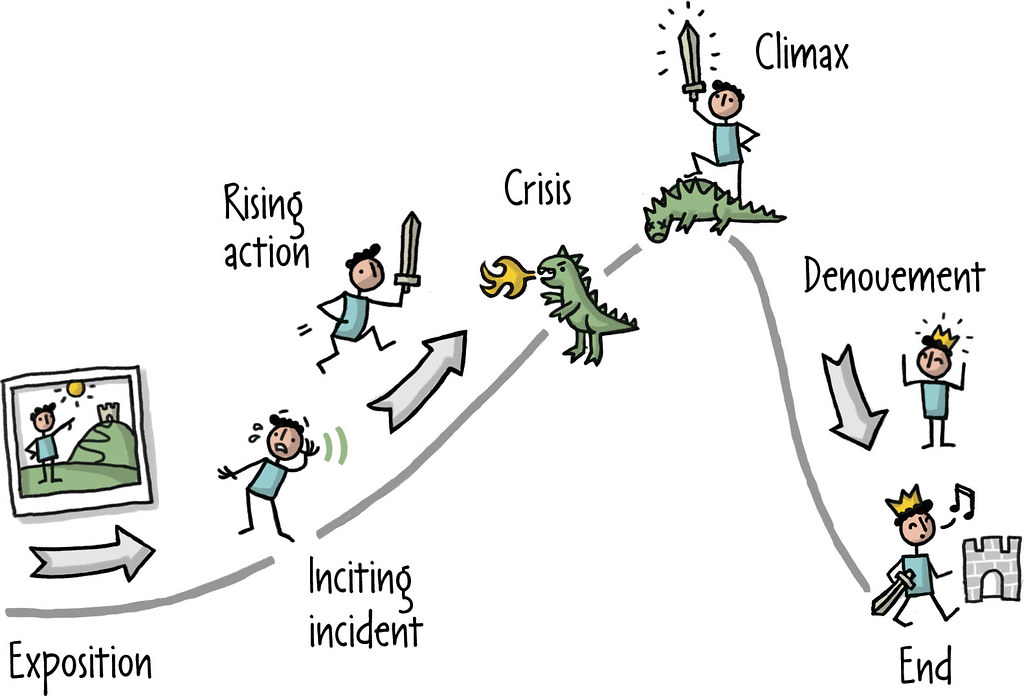 Character ARC, is, as you see here, very similar to the story arc, but is focused on the character rather than the plot. This arc often drives the plot, and sometimes the story arc and protgonist's arc have a lot of similar events and roadblocks. Here's where secondary character arcs come in. Secondary characters are either part of the roadblock or part of the solution, and sometimes both which will require both characters to grow, adapt and compromise. Character ARC, is, as you see here, very similar to the story arc, but is focused on the character rather than the plot. This arc often drives the plot, and sometimes the story arc and protgonist's arc have a lot of similar events and roadblocks. Here's where secondary character arcs come in. Secondary characters are either part of the roadblock or part of the solution, and sometimes both which will require both characters to grow, adapt and compromise.
XX
I'm currently writing book 2 in my Jesse Quinn mystery series. The main story arc is the solving of two crimes, that of repeating grafitti on a local church, and then the murder of the church's controversial pastor. Are they connected? Or is there something else going on? Jesse and her temporary partner have very different ideas so both characters will have to grow and adapt, compromise and in the process, learn to work together. My heroine, Jesse Quinn, a detective with the St John's County Sheriff's Department, also has a character arc outside of her position as detective that continues from book one into book two. She is divorced and shares custody of her two teenagers. The son is a decent kid that overcame some of his issues before the story opens, but the daughter is going through her early teen years pushing every button Jesse has. In this new book, Jacqui wants to live with her father and Jesse has to come to terms with the loss of the close friendship they shared before Jacqui hit her teen years, all the while trying to decide what is best for her daughter now and going forward. Then she's going to have to learn to live with whatever decisions she makes. It's a growth story for both Jesse and her daughter. And then there's Seth, the man who would like to be more in Jesse's life than he is up to now. Jesse isn't sure she's ready to take on another romantic entanglement while pursuing a career as the only woman on the major crimes squad. Her character arc adds depth and interest to the ongoing police investigation and realism to her life as a detective and a mom. Those of Seth and Jacqui add depth to Jesse's story.
XX
So, I challenge you to think about the stories that have stuck with you long after you watched or read them and think about what it was that made them so memorable. Why did you enjoy them? Why do you still think about the characters you met within those pages? I’m betting you will come to agree, it was their personal character arcs that made them impossible to forget, and the book impossible to put down or the TV series you couldn't wait to tune into each week.
XX
So, why not hop on over and see what my other Blog Hop Authors think about Character Arc.
XX
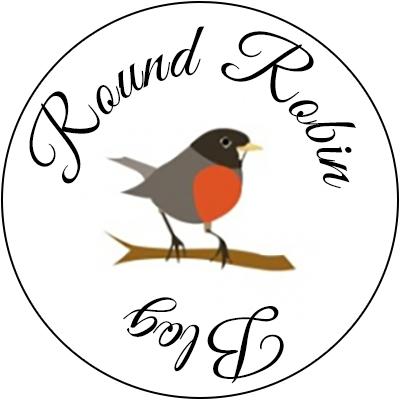 Anne Stenhouse Anne Stenhouse
Connie Vines
Diane Bator
Helena Fairfax
Marci Baun
Victoria Chatham
A.J. Maguire
Saturday, June 17 2023

For a long time, I believed that there were only two kinds of writers. Plotters! And Pantsers! But now I’ve learned that there are also hybrids.
 The first book I ever wrote was a free-for-all. I had no idea what I was doing, actually, except picking up the writing bug where I’d left off when I started my family and got too busy to write. I had a high school teacher whose very first assignment was to write 500 words on something I could smell. I’ll admit, my first thought was I’m DOOMED! I am sooo going to fail this class in creative writing. But I’d never deliberately skipped a homework assignment so I sat myself down and started writing. It’s probably a lucky thing that my mom had asked me to go take the sheets off the clothesline (See how old I am? We didn’t have dryers back when I was in high school.) Anyway, with the scent of freshly washed sheets strong in my nostrils, that’s what I wrote 520 words on. To my utter amazement, I got an A+ for the assignment. The first book I ever wrote was a free-for-all. I had no idea what I was doing, actually, except picking up the writing bug where I’d left off when I started my family and got too busy to write. I had a high school teacher whose very first assignment was to write 500 words on something I could smell. I’ll admit, my first thought was I’m DOOMED! I am sooo going to fail this class in creative writing. But I’d never deliberately skipped a homework assignment so I sat myself down and started writing. It’s probably a lucky thing that my mom had asked me to go take the sheets off the clothesline (See how old I am? We didn’t have dryers back when I was in high school.) Anyway, with the scent of freshly washed sheets strong in my nostrils, that’s what I wrote 520 words on. To my utter amazement, I got an A+ for the assignment.
XX
That entire exercise had been written entirely by the seat of my pants – no plotting, or even outlining. Just sat down and wrote. So it stands to reason that for several years in between that and my first attempt at a novel, everything I wrote was freestyle. I still have that first mostly written novel in a file somewhere. Written in pencil on yellow lined paper since I didn’t even own a typewriter and personal computers didn’t exist yet. Since that time, I’ve attended many workshops and a lot of conferences where I’ve been faced with other options.
XX
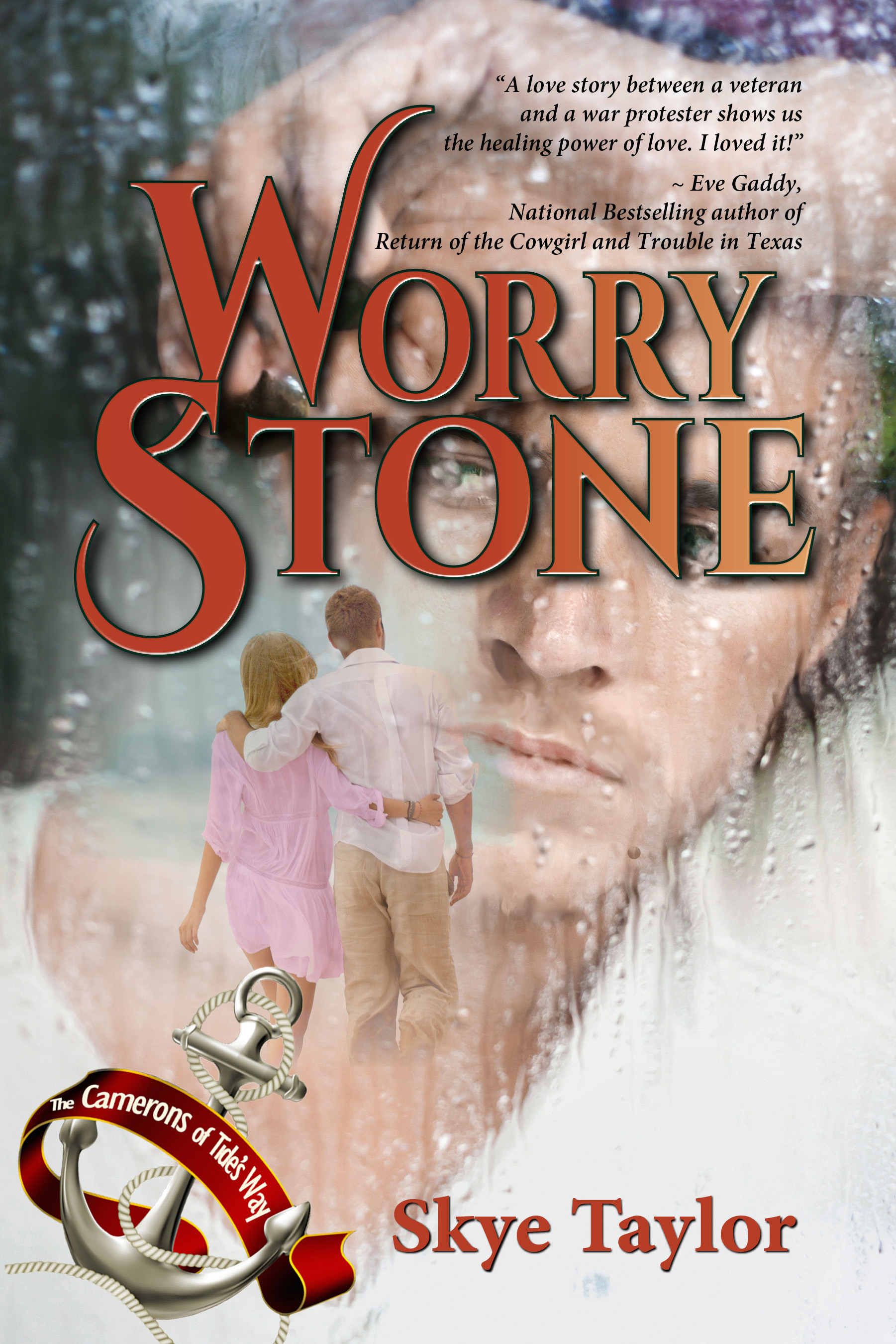 But I was still a die-hard pantser. Worry Stone, which later became part of my romance series, was written pretty much by the seat of my pants, but it wasn’t entirely freestyle like my essay on the scent of freshly laundered sheets. I created my characters first. I even knew my main character’s entire life story pretty much. Since it involved some real places and the background of a war, I did a lot of research as well. My hero was a Marine in Vietnam and came home to cope with his own demons as well as the heap of guilt our country loaded on every returning soldier, so I consulted my brother among others – a man who had been there, done that and was generous enough to relive some of his heartbreak and memories with me. Of all the ten books I now have in print (or ebook) I still think it’s my best. (BTW, Worry Stone won Silver in the Royal Palm Literary Awards in 2019 and I think it’s the best I’ve written so far.) But I was still a die-hard pantser. Worry Stone, which later became part of my romance series, was written pretty much by the seat of my pants, but it wasn’t entirely freestyle like my essay on the scent of freshly laundered sheets. I created my characters first. I even knew my main character’s entire life story pretty much. Since it involved some real places and the background of a war, I did a lot of research as well. My hero was a Marine in Vietnam and came home to cope with his own demons as well as the heap of guilt our country loaded on every returning soldier, so I consulted my brother among others – a man who had been there, done that and was generous enough to relive some of his heartbreak and memories with me. Of all the ten books I now have in print (or ebook) I still think it’s my best. (BTW, Worry Stone won Silver in the Royal Palm Literary Awards in 2019 and I think it’s the best I’ve written so far.)
XX
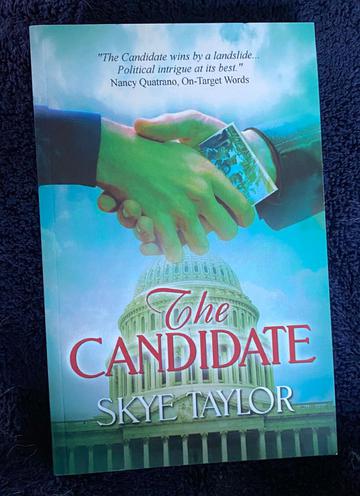 My second-best book (IMHO,) and my first to be published, The Candidate, was written very much the same way. The Candidate is a main stream novel set in today’s world, but the protagonist was another Marine who had fought in Vietnam and is now running for president when he is handed a photo that brings back memories he never wanted to revisit and emotions he wasn’t ready to cope with, especially not in the midst of a run for the White House. I had done most of the research so again, it was just a matter of creating believable, compelling characters and letting them run with the story. I was as entertained by the unfolding story as my readers and I enjoyed writing that way. My second-best book (IMHO,) and my first to be published, The Candidate, was written very much the same way. The Candidate is a main stream novel set in today’s world, but the protagonist was another Marine who had fought in Vietnam and is now running for president when he is handed a photo that brings back memories he never wanted to revisit and emotions he wasn’t ready to cope with, especially not in the midst of a run for the White House. I had done most of the research so again, it was just a matter of creating believable, compelling characters and letting them run with the story. I was as entertained by the unfolding story as my readers and I enjoyed writing that way.
xx
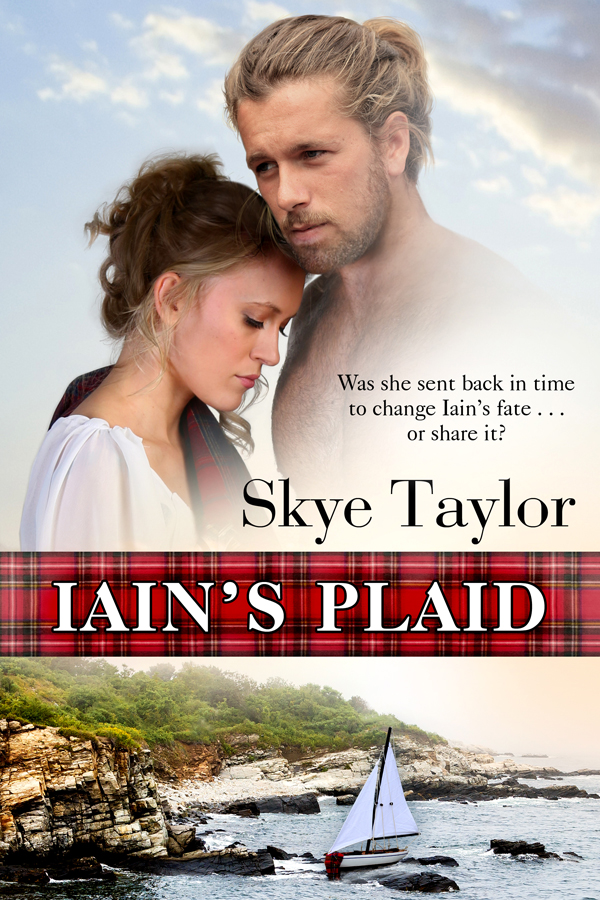 The first full length novel I completed was inspired by an exploration of a long-abandoned island off the coast of Maine with a lot of history. As I stood on the edge of a larger than usual cellar hole, the granite I was perched on moved alarmingly and I jumped free, not wishing to fall in. But I have a writer’s brain that finds stories everywhere and on my way home it occurred to me to wonder what if I had fallen in and hit my head and then woken in another century? So, of course, Dani, my heroine in Iain’s Plaid does just that and wakes up in 1775 in the basement of a warehouse whose owner has a ship loaded with contraband headed to Boston and he thinks she’s a spy. It’s a time travel and a romance but I did a ton of research, walking the streets of Boston, reading journals and letters from the period. But aside from that, the book was written entirely by the seat of my pants. The ONLY guiding star for that book was that I knew before I started writing it, how it would end. In fact, I wrote the last chapter first. I traveled that journey, knowing where I was going but with no road map. The first full length novel I completed was inspired by an exploration of a long-abandoned island off the coast of Maine with a lot of history. As I stood on the edge of a larger than usual cellar hole, the granite I was perched on moved alarmingly and I jumped free, not wishing to fall in. But I have a writer’s brain that finds stories everywhere and on my way home it occurred to me to wonder what if I had fallen in and hit my head and then woken in another century? So, of course, Dani, my heroine in Iain’s Plaid does just that and wakes up in 1775 in the basement of a warehouse whose owner has a ship loaded with contraband headed to Boston and he thinks she’s a spy. It’s a time travel and a romance but I did a ton of research, walking the streets of Boston, reading journals and letters from the period. But aside from that, the book was written entirely by the seat of my pants. The ONLY guiding star for that book was that I knew before I started writing it, how it would end. In fact, I wrote the last chapter first. I traveled that journey, knowing where I was going but with no road map.
xx
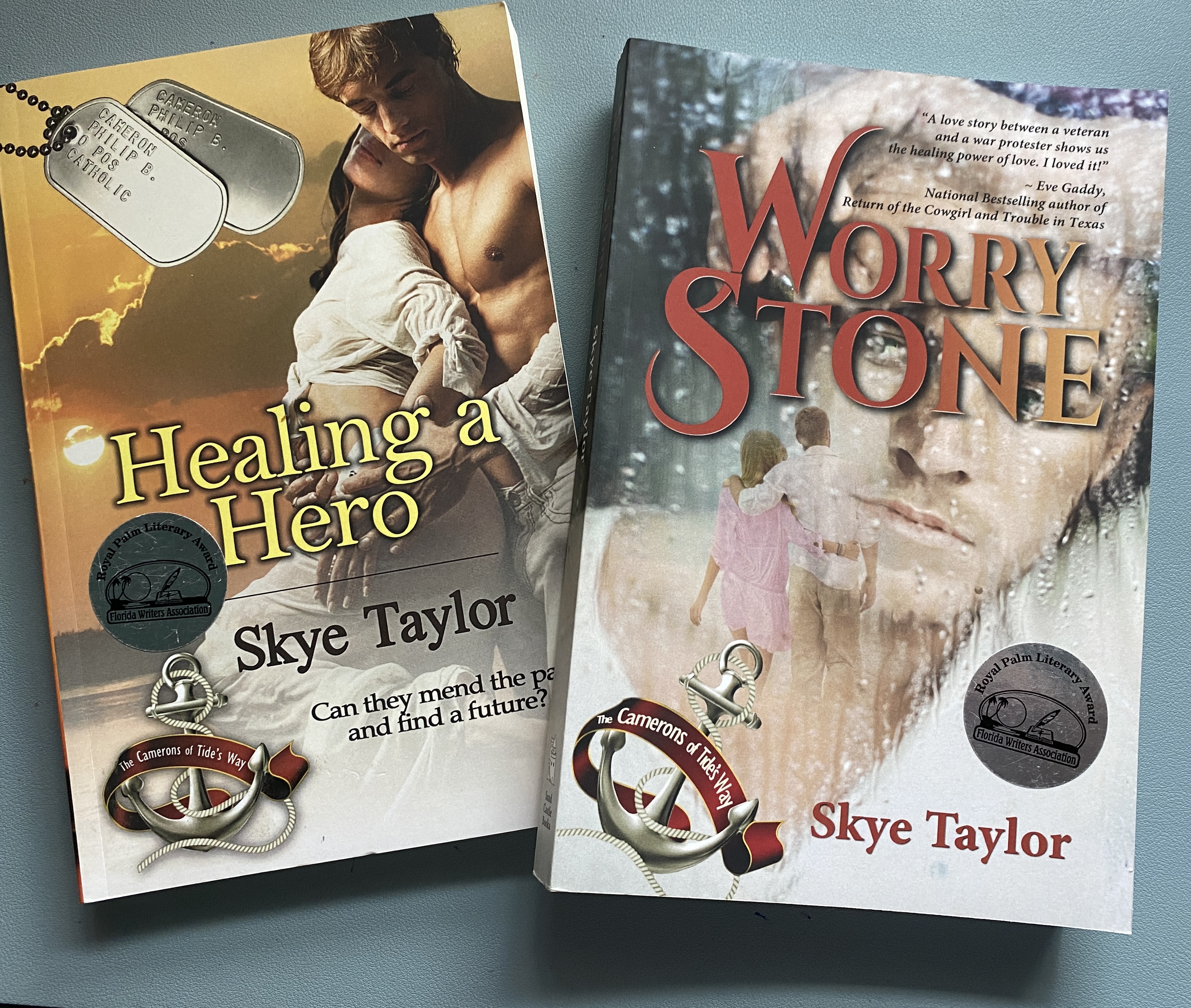 After that my romance series began. By then I’d been presented with all the plusses for outlining before writing, or plotting the story first. I even have several books on my shelf presenting different ways to go about plotting. But it never seemed to work. I had more fun creating my hero and heroine, giving them a setting and a problem and then letting them sort it out. One of the books in the Camerons of Tide’s Way series, Healing A Hero, also won Silver in the Royal Palm Literary Awards two years before Worry Stone did. It appeared, in spite of my efforts to plot or plan ahead, I was doing okay with my pantser method of writing. After that my romance series began. By then I’d been presented with all the plusses for outlining before writing, or plotting the story first. I even have several books on my shelf presenting different ways to go about plotting. But it never seemed to work. I had more fun creating my hero and heroine, giving them a setting and a problem and then letting them sort it out. One of the books in the Camerons of Tide’s Way series, Healing A Hero, also won Silver in the Royal Palm Literary Awards two years before Worry Stone did. It appeared, in spite of my efforts to plot or plan ahead, I was doing okay with my pantser method of writing.
xx
But then I decided to write a mystery. Did my research: Attended the local Citizens Law Enforcement Academy, interviewed the only female detective on the major crimes squad at the time, and set it in my hometown so I could visit anything or place I needed to in the course of writing it. I liked my heroine, Jesse Quinn. And I had a pretty good idea how the story would end, but what I’d failed to realize is that a good mystery can’t suddenly fling things at a reader that come out of nowhere. The writer has to know who did it, why they did it, how? And all the red herrings have to make sense. Which meant PLOTTING. Bullseye has done pretty well and I’m part way through the second book in that series which I hope to have out next fall, but plotting still does not come naturally to me. I’ve got yet another trade book, Take Your Pants Off at hand and have been trying to follow the very sound and proven advice that it isn’t plotting so much as outlining. Understanding what events have to happen and the sequence they have to happen in to make sense and give the reader a satisfying ending.
xx
That makes me a hybrid. But all in all, I prefer the pantser method. I urge you now, to hop on over and check out how my fellow Round Robin Authors write their stories.

xx
Marci Baun
Dr Bob Rich
Anne Stenhouse
Helena Fairfax
Saturday, May 20 2023
This month we are discussing emotional wounds for our protagonists – is it important? And if so, how do we help our heroes and heroines overcome the wounds and heal, or learn how to cope?
xx
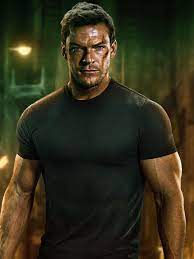 There are protagonists in some very popular novels and series that don’t appear to have any emotional wounds, or if they do, they are never mentioned. Consider Jack Reacher – ex Army, unmarried, no kids, one brother in jail and a dad in assisted living. One might consider either of those issues a wound, but Lee Child did not use them that way. Reacher seems to be a man at peace with himself and his vagabond life. His mission in life, while never stated by Reacher himself, but obvious as the series unfolds, is to get involved when someone without the ability to fix things is being hurt in some way by forces stronger than themselves. And in spite of the mayhem he often leaves in his wake, he somehow avoids getting into trouble with the law. And devotees to the series love Jack Reacher, whether in the books written by Child or on the TV series featuring Alan Ritchson. There are protagonists in some very popular novels and series that don’t appear to have any emotional wounds, or if they do, they are never mentioned. Consider Jack Reacher – ex Army, unmarried, no kids, one brother in jail and a dad in assisted living. One might consider either of those issues a wound, but Lee Child did not use them that way. Reacher seems to be a man at peace with himself and his vagabond life. His mission in life, while never stated by Reacher himself, but obvious as the series unfolds, is to get involved when someone without the ability to fix things is being hurt in some way by forces stronger than themselves. And in spite of the mayhem he often leaves in his wake, he somehow avoids getting into trouble with the law. And devotees to the series love Jack Reacher, whether in the books written by Child or on the TV series featuring Alan Ritchson.
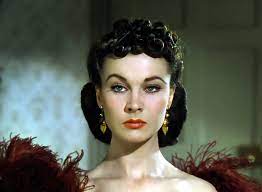 But not all heroes or heroines are so fortunate. And it is, in fact, the emotional baggage they bring to the stories that make them memorable or loveable. Even Scarlet O’Hara had her issues, in love with another woman’s husband and unable to appreciate the love and forbearance of Rhett Butler, who, in the end declares, “Frankly, my Dear, I don’t give a damn.” While Scarlett’s personality is such that she’s a hard woman to love, she is very real and relatable. And everyone can relate to Rhett who gave her everything, but found it wasn’t enough. But not all heroes or heroines are so fortunate. And it is, in fact, the emotional baggage they bring to the stories that make them memorable or loveable. Even Scarlet O’Hara had her issues, in love with another woman’s husband and unable to appreciate the love and forbearance of Rhett Butler, who, in the end declares, “Frankly, my Dear, I don’t give a damn.” While Scarlett’s personality is such that she’s a hard woman to love, she is very real and relatable. And everyone can relate to Rhett who gave her everything, but found it wasn’t enough.
xx
 For most readers, it’s the emotional wounds that make us care about the characters. The kid from the wrong side of town, from a dysfunctional family, who desperately wants to be like everyone else. Or the woman who was abused by a family member and has to overcome that to find love as an adult. The veteran who put his life on the line and comes home to cope with PTSD, his wife and kids, all are victims of an emotional wound that has to be faced and lived with before life can be good again. Some wounds are huge. Some smaller but still affect the lives of those who live with them. For most readers, it’s the emotional wounds that make us care about the characters. The kid from the wrong side of town, from a dysfunctional family, who desperately wants to be like everyone else. Or the woman who was abused by a family member and has to overcome that to find love as an adult. The veteran who put his life on the line and comes home to cope with PTSD, his wife and kids, all are victims of an emotional wound that has to be faced and lived with before life can be good again. Some wounds are huge. Some smaller but still affect the lives of those who live with them.
xx
 When I was a small child, our family had dinner with a relative and on the way home, we were passed by several emergency vehicles, sirens blaring, lights flashing. Then we saw the orange glow in the sky and my dad, always fascinated by the heroism and activity of firemen, followed to see what he could see. Imagine my five-year-old horror at the sight of a house with flames surging from the windows and billows of smoke rising into an evening sky brightly lit by the awful fire. Might not seem much like an emotional wound but I had nightmares for years about my own home going up in flames while I slept at night. Now how might I use such an experience for a protagonist of my own? Perhaps it was a woman who fell in love with a fireman – talk about conflict and adding anxiety she would have to learn how to overcome to make a life with that man. When I was a small child, our family had dinner with a relative and on the way home, we were passed by several emergency vehicles, sirens blaring, lights flashing. Then we saw the orange glow in the sky and my dad, always fascinated by the heroism and activity of firemen, followed to see what he could see. Imagine my five-year-old horror at the sight of a house with flames surging from the windows and billows of smoke rising into an evening sky brightly lit by the awful fire. Might not seem much like an emotional wound but I had nightmares for years about my own home going up in flames while I slept at night. Now how might I use such an experience for a protagonist of my own? Perhaps it was a woman who fell in love with a fireman – talk about conflict and adding anxiety she would have to learn how to overcome to make a life with that man.
xx
 There are dozens of wounds that our protagonists can have. One of the resources I have on my desk is The Emotional Wound Thesaurus – A Writer’s Guide to Psychological Trauma. It has over 100 traumas that people experience and live with including examples from crime and victimization, disabilities and disfigurements, failures and mistakes, injustice and hardship, betrayal, childhood wounds and traumatic events. It’s an amazing resource whether you are creating a character and plot from the beginning or have a basic plot but are looking for a monkey wrench to throw into your protagonist’s life and ability to get to his or her goal. There are dozens of wounds that our protagonists can have. One of the resources I have on my desk is The Emotional Wound Thesaurus – A Writer’s Guide to Psychological Trauma. It has over 100 traumas that people experience and live with including examples from crime and victimization, disabilities and disfigurements, failures and mistakes, injustice and hardship, betrayal, childhood wounds and traumatic events. It’s an amazing resource whether you are creating a character and plot from the beginning or have a basic plot but are looking for a monkey wrench to throw into your protagonist’s life and ability to get to his or her goal.
xx
 Not very many people reach adulthood without some struggle as a kid and most of us don’t get through life without running into trauma of one kind or another. Everyday things like being rear-ended and sent to the hospital which has you scared every time a car gets too close, too fast for years afterward. Not so common like a miscarriage, or being stood up at the altar. Or passed over for a well-deserved promotion at work. Or the really awful ones like losing someone you love in a horrible accident, being raped, living through a plane crash, losing everything you have and ending up on the street. The one thing all these have in common is that as readers we can feel sympathy and want the hero or heroine to find a way to overcome. And that makes readers keep turning pages because they want to experience a happy ending along with the protagonist. And isn’t that what we as authors are shooting for? Not very many people reach adulthood without some struggle as a kid and most of us don’t get through life without running into trauma of one kind or another. Everyday things like being rear-ended and sent to the hospital which has you scared every time a car gets too close, too fast for years afterward. Not so common like a miscarriage, or being stood up at the altar. Or passed over for a well-deserved promotion at work. Or the really awful ones like losing someone you love in a horrible accident, being raped, living through a plane crash, losing everything you have and ending up on the street. The one thing all these have in common is that as readers we can feel sympathy and want the hero or heroine to find a way to overcome. And that makes readers keep turning pages because they want to experience a happy ending along with the protagonist. And isn’t that what we as authors are shooting for?
xx
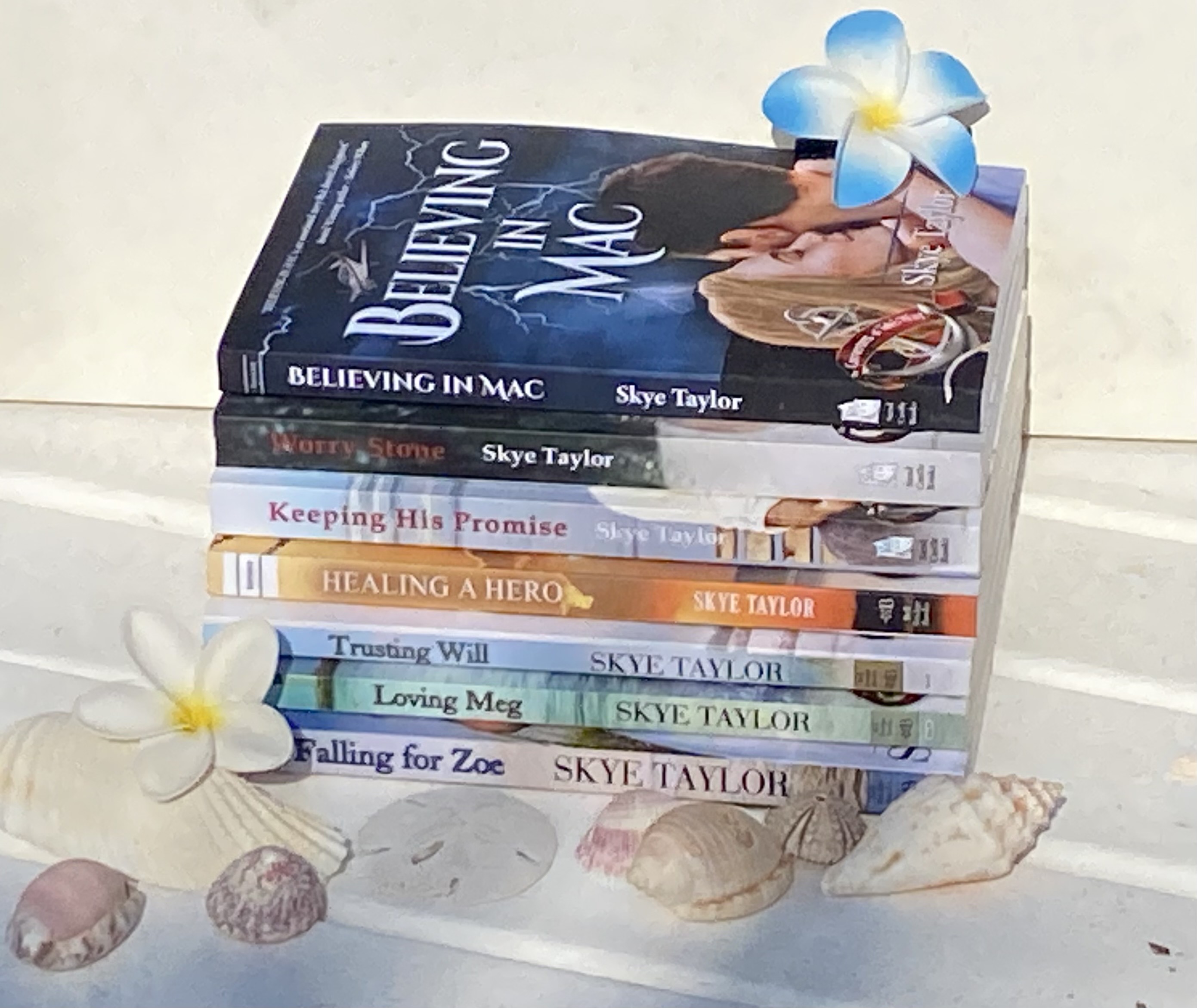 In my romance series I've got a hero and heroine in Healing a Hero who fell in love but due to events beyond their control were separated in such a way that both felt the other had abandoned their relationship and here they are 14 years later, both dealing with that betrayal in spite of being drawn together just as strongly as before. In Loving Meg, my heroine is the one who went to war and comes home to deal with the guilt and trauma and it is the persistent presence of a dog who is also coping with the loss of his police handler who helps her to open up and heal. Falling for Zoe features a heroine who got pregnant but the man she thought loved her wanted no part of having a child or even continuing their relationship. It's a romance though, so she ends up falling in love with a man who already has too many women in his life, but he's the perfect guy to help her make her life whole again. My heroine in Trusting Will is the widow of a soldier and is fearful of giving her heart to another man who puts his life on the line every day as a law enforcement officer. She has to learn that not letting herself love a man is more isolating and painful than taking a chance on love again. In my general fiction, The Candidate, Matt Steele finds himself dealing with the long buried trauma of war years later in the midst of a political campaign for the White House and it is in going back to the emotions and memories he wanted to bury forever that brings understanding and healing. Even in my murder mystery, Bullseye, my heroine, the only female detective on the major crimes squad, is good at her job, but copes with fellow detectives who feel she belongs on patrol, a husband who left her for a younger woman and a teenage daughter who thinks mom knows nothing. All of these traumas are what make my heroes and heroines someone my readers care about and want to see them overcome the obstacles in their lives. In my romance series I've got a hero and heroine in Healing a Hero who fell in love but due to events beyond their control were separated in such a way that both felt the other had abandoned their relationship and here they are 14 years later, both dealing with that betrayal in spite of being drawn together just as strongly as before. In Loving Meg, my heroine is the one who went to war and comes home to deal with the guilt and trauma and it is the persistent presence of a dog who is also coping with the loss of his police handler who helps her to open up and heal. Falling for Zoe features a heroine who got pregnant but the man she thought loved her wanted no part of having a child or even continuing their relationship. It's a romance though, so she ends up falling in love with a man who already has too many women in his life, but he's the perfect guy to help her make her life whole again. My heroine in Trusting Will is the widow of a soldier and is fearful of giving her heart to another man who puts his life on the line every day as a law enforcement officer. She has to learn that not letting herself love a man is more isolating and painful than taking a chance on love again. In my general fiction, The Candidate, Matt Steele finds himself dealing with the long buried trauma of war years later in the midst of a political campaign for the White House and it is in going back to the emotions and memories he wanted to bury forever that brings understanding and healing. Even in my murder mystery, Bullseye, my heroine, the only female detective on the major crimes squad, is good at her job, but copes with fellow detectives who feel she belongs on patrol, a husband who left her for a younger woman and a teenage daughter who thinks mom knows nothing. All of these traumas are what make my heroes and heroines someone my readers care about and want to see them overcome the obstacles in their lives.
XX
 Check out my fellow Round Robin Bloggers for their take on the topic of the month. Check out my fellow Round Robin Bloggers for their take on the topic of the month.
XX
Connie Vines
Dr. Bob Rich
Fiona McGier
Marci Baun
Victoria Chatham
Saturday, April 22 2023
Breathing Life into your Characters
 XX XX
April is here and things are blooming everywhere, so, our Round Robin Blog Hoppers are discussing how they make their characters to spring into life.
XX
With a few rare exceptions where the action is the WHOLE story, it’s the characters that draw me into a good book and keep me turning pages. I want to become invested in the people between the pages. I want to cheer them on, cry with them, care about their relationships and lives. And I want them to be happy and satisfied with the outcome on the last page. But to make me care, the author has to make those characters real. Paper dolls and characters with no character, just don’t cut it.
XX
I did a workshop on this topic recently and I asked the authors attending the presentation to take a moment to think about their favorite characters from the book or TV series they loved and eagerly looked forward to every new installment. Or think about a book they’ve read at any point in their life where the main character claimed them and they’ve never forgotten the character, perhaps even years later.
XX
For me that goes back a long way. As a child I was in love with Heidi. I wanted to be Heidi. I wanted to live on that mountain with the Grandfather and Peter. I still recall how deeply I cared, so what made me care, and still remember all these years later? Because Johanna Spyri made me care about Heidi. A 5-year old orphan who is taken by her aunt to live with her reclusive grandfather far away from the village and anything she’s ever known in her short life. How could you not care about her? But she’s cheerful and friendly. She falls in love with Peter and his goats and begs to go up the mountain with them every day. A carefree lifestyle most kids who are tied to school and routine would envy. Heidi wins over the grumpy old grandfather along with her readers.
XX
Well, I’m no longer a child, and I’ve become a little more demanding in what kind of characters grab my attention and devotion. I don’t want to read about billionaires or super models without a care in the world. I’m not drawn to characters I can’t get into the hearts and minds of. An example of what draws me might be the comparison between Kensi Blye and Marty Deeks on NCIS LA.
 XX XX
Kensi is a bigger than life heroine. She is fluent in Portuguese, French, Spanish, Japanese. She knows Morse code and can lip read. She’s an ace sniper, excellent tracker. She can fix engines, plays poker, knows how to wire a house. She can and does defeat men twice her size in physical combat. In fact, she’s almost too big to be believable. But where are her flaws? Mostly she comes across as invincible.
XX
Then there’s Marty, who begins in the series as a borrowed undercover officer from LAPD. With his scruff and unkempt blond hair he looks more like a surfer than a cop or an NCIS agent. He has an almost boyish attitude and a quirky sense of humor. He gets beat up on occasion and is sometimes treated as the odd man out, which he spends a good deal of time trying to overcome. And yet – he comes across to me (the reader or TV watcher) as more believable than his partner Kensi. I find myself rooting for him far more often than for Callen or even Sam Hanna when the chase is on. And I’m only concerned about Kensi because Deeks loves her and anything that hurts her, hurts Deeks.
XX
 One heroic character that has become an international phenomenon and even if you haven’t watched the Outlander series or read the books, you may still have heard of him. Jamie Fraser. Do a brief search on social media and you’ll quickly find what drives his popularity. A short list includes: honorable, loyal, loving, faithful, passionate, romantic, brave, flawed, funny, vulnerable and the way he treats Claire. One heroic character that has become an international phenomenon and even if you haven’t watched the Outlander series or read the books, you may still have heard of him. Jamie Fraser. Do a brief search on social media and you’ll quickly find what drives his popularity. A short list includes: honorable, loyal, loving, faithful, passionate, romantic, brave, flawed, funny, vulnerable and the way he treats Claire.
He’s educated, a soldier, a laird, brother, son, and leader – and yet at the start of the first book, he is barely into his 20s. He is an outlaw wanted by the British but revered by the Scots. Personally, he is both a keen observer of those around him, fiercely loyal, and willing to be openly emotional. He is scarred, both physically (from beatings his nemesis Jack Randall loves to inflict on him) and emotional. When he falls in love with time traveler, Clair, that brings a whole new raft of vulnerabilities to what started out as a wounded, yet independent young warrior. In the author ‘s own words: “Jamie was created by a woman to be simultaneously masculine, yet vulnerable. Someone you could trust with your life and feel compelled to care for. Innocent yet wise, capable of showing emotion. Takes responsibility for his mistakes, is fiercely loyal devoted and loyal.
XX
That’s the kind of character that draws me into the story right from the start and keeps me there, eager for the next chapter, reluctant to put the book down, and on the last page feeling as if my best friend just moved a thousand miles away.
XX
 Comedy is a whole other world. One doesn’t have to be a Kensi Blye. But still, consider over the years, what makes a comedic character of either sex compelling. It’s their FLAWS! Dick Van Dyke could trip over his own feet, or Lucille Ball who half the time had her foot in her mouth. Barney Fife who’s afraid of his own shadow. Writing comedy is a Comedy is a whole other world. One doesn’t have to be a Kensi Blye. But still, consider over the years, what makes a comedic character of either sex compelling. It’s their FLAWS! Dick Van Dyke could trip over his own feet, or Lucille Ball who half the time had her foot in her mouth. Barney Fife who’s afraid of his own shadow. Writing comedy is a 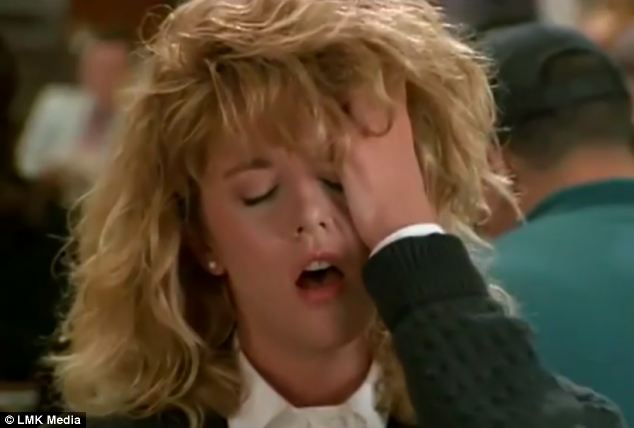 craft very different from suspense, mystery, or drama, but the characters still have to be compelling with both admirable and flawed characteristics to make them believable beyond the caricature! Think of Sheldon Cooper on the Big Bang Theory who is the so over the top Brainiac, but struggles with personal relationships and OCD tendencies. Or Sally Albright in the movie When Harry Met Sally who is equally flawed, yet captured instant attention by proving a woman could fake an orgasm that a man would never know wasn’t real – in the middle of a restaurant and embarrassing Harry completely. The fun is in the flaws as well as the strengths. In fact, neither of these characters would be compelling without their flaws. craft very different from suspense, mystery, or drama, but the characters still have to be compelling with both admirable and flawed characteristics to make them believable beyond the caricature! Think of Sheldon Cooper on the Big Bang Theory who is the so over the top Brainiac, but struggles with personal relationships and OCD tendencies. Or Sally Albright in the movie When Harry Met Sally who is equally flawed, yet captured instant attention by proving a woman could fake an orgasm that a man would never know wasn’t real – in the middle of a restaurant and embarrassing Harry completely. The fun is in the flaws as well as the strengths. In fact, neither of these characters would be compelling without their flaws.
XX
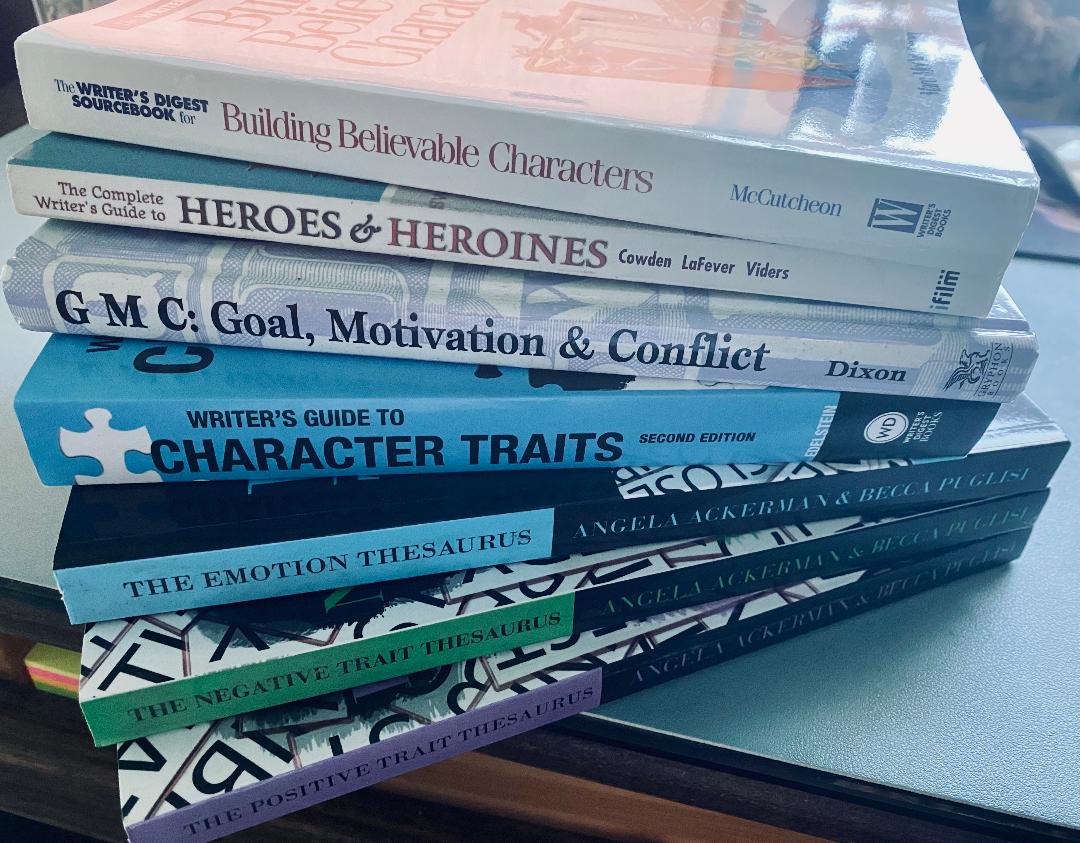 So, where do you begin to find these flaws. I have a whole shelf of books to consult, but I might start with people I know. I never copy a specific individual, but I might borrow their mannerisms, faults, habits and speech. There are people in the news with a vast array natures, behaviors and dispositions I’ve never encountered personally. And when there are holes still to fill, I have a whole shelf of books to consult. A series of books – The Writer’s Guide Thesauruses, that includes Character Flaws, Negative Traits, Positive Traits, Careers and Psychological Traumas. (This last one is a great way to figure out WHY your character came by his or her flaw, or what drives them to behave the way they do.) My shelf also has Heroes & Heroines – Sixteen Master Archetypes, Building Believable Characters – by Marc McCutcheon So, where do you begin to find these flaws. I have a whole shelf of books to consult, but I might start with people I know. I never copy a specific individual, but I might borrow their mannerisms, faults, habits and speech. There are people in the news with a vast array natures, behaviors and dispositions I’ve never encountered personally. And when there are holes still to fill, I have a whole shelf of books to consult. A series of books – The Writer’s Guide Thesauruses, that includes Character Flaws, Negative Traits, Positive Traits, Careers and Psychological Traumas. (This last one is a great way to figure out WHY your character came by his or her flaw, or what drives them to behave the way they do.) My shelf also has Heroes & Heroines – Sixteen Master Archetypes, Building Believable Characters – by Marc McCutcheon
Characters Emotional and Viewpoint – by Nancy Kress and Creating Character Arcs – by K. M. Weiland
XX
 That Character ARC is another important part of creating characters who resonate. Another invaluable resource is Goal, Motivation & Conflict by Debra Dixon. What does your character want? Why do they want it? And what stumbling blocks are in their way? Filling out a GMC chart for your character will help to bring their character arc into play. And it also helps to show where the weak places in your character’s make up might be. That Character ARC is another important part of creating characters who resonate. Another invaluable resource is Goal, Motivation & Conflict by Debra Dixon. What does your character want? Why do they want it? And what stumbling blocks are in their way? Filling out a GMC chart for your character will help to bring their character arc into play. And it also helps to show where the weak places in your character’s make up might be.
XXX
And don’t forget the conflict between your characters that heightens both their strengths and the weaknesses. Sheldon Cooper is surrounded by a group of friends, each with their own personality that his either clashes with or is highlighted by. And the interaction between them shows off what kind of person he is. By himself, he appears to be a super smart guy with obsessive habits, but because of the rest of the cast we see into his caring side. When he worries about Raj, or Penny, and argues with Leonard or Amy, that lets the viewer see deeper into his personality and makes him a character you can care about.
XXX
 So, how are we going to make sure our stories and characters are just as compelling? Start with the things about YOUR favorite characters that you find compelling, loveable or the opposite. You’ll probably find pretty quickly that you did not describe them physically right at the start. In fact, physical appearance might or might not change as you develop other characters. For the most part, I’m betting you wrote down things like I mentioned before about the well-known fictional characters. So, how are we going to make sure our stories and characters are just as compelling? Start with the things about YOUR favorite characters that you find compelling, loveable or the opposite. You’ll probably find pretty quickly that you did not describe them physically right at the start. In fact, physical appearance might or might not change as you develop other characters. For the most part, I’m betting you wrote down things like I mentioned before about the well-known fictional characters.
XXX
 How important is it to dig deep into secondary characters? Ask yourself, Do they serve a purpose? Do they drive the plot or are they just placeholders. Sometimes characters like the waiter shouldn’t even get a name, never mind a character outline. Unless it’s a small-town diner where the waitress knows you and everyone else in town by name. But if your secondary characters are going to move your plot or your heroine, they need to have careful thought put into them as well, emphasizing those characteristics they have that impact your main characters or the story. How important is it to dig deep into secondary characters? Ask yourself, Do they serve a purpose? Do they drive the plot or are they just placeholders. Sometimes characters like the waiter shouldn’t even get a name, never mind a character outline. Unless it’s a small-town diner where the waitress knows you and everyone else in town by name. But if your secondary characters are going to move your plot or your heroine, they need to have careful thought put into them as well, emphasizing those characteristics they have that impact your main characters or the story.
XX
 What about Villains and antagonists? A villain needs to be just as compelling as your hero to make the conflict believable. The antagonist just needs to make waves and disagree with your hero and heroine. Both are stumbling blocks. They might be unpredictable, sociopathic, narcissistic or use fear to get their way, but they MUST HAVE REASONS – Revenge, Hate, Greed, Sex, Drugs for a few examples. Allow your reader to feel some connection to your villain. Maybe they are motivated by Religion, A need to be liked or a Need for attention What about Villains and antagonists? A villain needs to be just as compelling as your hero to make the conflict believable. The antagonist just needs to make waves and disagree with your hero and heroine. Both are stumbling blocks. They might be unpredictable, sociopathic, narcissistic or use fear to get their way, but they MUST HAVE REASONS – Revenge, Hate, Greed, Sex, Drugs for a few examples. Allow your reader to feel some connection to your villain. Maybe they are motivated by Religion, A need to be liked or a Need for attention
XX
 Basic villain types include: The Classic villain (Sociopath, self-interest, Rules don’t apply to him and Not redeemable) The Supernatural villain who uses sorcery or has some special paranormal power But this villain must have a weakness like Superman’s Kryptonite. The Bond Villain who is Rich, Powerful, Larger than Life, Has a following of henchmen, Enjoys the crime or is an Egomaniac. And of course, Rivals like the Evil Twin, the Femme Fatale or the Bully. Basic villain types include: The Classic villain (Sociopath, self-interest, Rules don’t apply to him and Not redeemable) The Supernatural villain who uses sorcery or has some special paranormal power But this villain must have a weakness like Superman’s Kryptonite. The Bond Villain who is Rich, Powerful, Larger than Life, Has a following of henchmen, Enjoys the crime or is an Egomaniac. And of course, Rivals like the Evil Twin, the Femme Fatale or the Bully.
XX
The most important part of your story, unless you’re Lee Child, are the characters, so take the time to make them real, compelling, and memorable. Things to remember about ALL your characters’ flaws and strengths – there NEEDS TO BE A REASON
 XX XX
Try asking yourself how other writers have convinced you to care about your favorite characters. What did they show you about that character that made them so compelling and HOW did they show it. Backstory dumps are a huge no-no so don’t use this to tell your readers why your character is what he or she is. Find ways to show the reader in the action, in how they relate to other characters, or how they react to love, threats, sadness etc.
XX
One last hint I’ll leave you with – after you’ve created your character, pretend you are a reporter for the local paper and interview your character as if you will be writing a feature article for this Sunday’s paper. Ask the tough personal questions. Dig for dirt. Make them squirm. Make them explain their goals and why they are so important. If you know your character this well, he or she will shine in the story you are writing.
XX
Time to visit the rest of our Round Robin Authors and find out how they create great characters.
XX
 Anne Stenhouse Anne Stenhouse
Connie Vines
Diane Bator
Dr. Bob Rich
Fiona McGier
Marci Baun
Victoria Chatham
A.J. Maguire
Helena Fairfax
Judith Copek
Friday, March 17 2023
Our Round Robin Blog Hop for March is: The Importance of your character's backstory/history and how to share this with the reader.
xx
 Backstory is what gives both the characters and the plot depth and meaning. Without it, neither the author nor the reader really knows who the characters are or why the story is going where it’s going. We’ve all read books that seem totally shallow, mere vehicles for violence or sex or sometimes humor but without much character growth or story arc. But, thankfully, most authors do know their character’s backstory. So, then the question becomes how much should the author reveal? When? And how? We’ve all come across books with major info dumps, and that’s just as much of a story killer. Backstory is what gives both the characters and the plot depth and meaning. Without it, neither the author nor the reader really knows who the characters are or why the story is going where it’s going. We’ve all read books that seem totally shallow, mere vehicles for violence or sex or sometimes humor but without much character growth or story arc. But, thankfully, most authors do know their character’s backstory. So, then the question becomes how much should the author reveal? When? And how? We’ve all come across books with major info dumps, and that’s just as much of a story killer.
xx
If the author decides there is so much “important stuff” about their characters that the reader just has to know ahead of time, they often decide on a prologue. That can work both ways. Some people ignore prologues and just flip pages to chapter 1. They then miss the things that drive the character to make the decisions they make and leave the reader scratching his head wondering “why?” 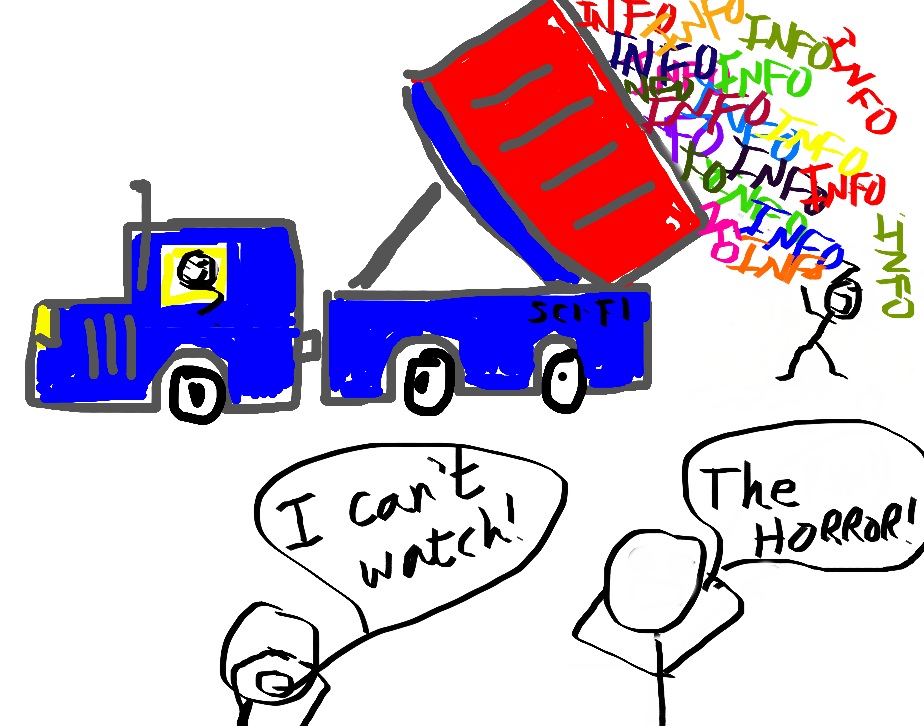 This habit also leaves the reader in the dark about the character’s growth, healing, or resolution of past issues that had been holding them back. But some editors and readers love prologues for all the information they can deliver. Your choice. This habit also leaves the reader in the dark about the character’s growth, healing, or resolution of past issues that had been holding them back. But some editors and readers love prologues for all the information they can deliver. Your choice.
xx
Another story killing option is to save it for chapter one and just lay it all out there on the first few pages or even chapters. Unfortunately this can end with the reader putting the book aside. No action, nothing happening = no hook. Even if they keep reading and finish, when they post a review it will nearly always begin with something like – “It was a good story, but it started slow.” “Or I had a hard time getting into the story.” So, not your best option.
xx
So, if prologues and info dumps are both iffy choices, how does the author tell the reader the important parts of a character’s backstory, or the events leading up to and causing the inciting incident in the plot?
 xx xx
The first thing to remember is that while you know, or should know, your characters as well as you know yourself or at least your best friend, not everything you know about them needs to appear in the story. For instance, maybe your hero had his tonsils out when he was five. Traumatic for a five-year old, especially when he’s been promised all the ice cream he wants when the surgery is over and then discovers his throat hurts so much he doesn’t want any ice cream. But your hero is now  32 and he’s a soldier or a fireman, his disappointment over the ice cream issue has no bearing on the choices he makes today and this tid-bit, however amusing, isn’t important. UNLESS – another part of the five-year-old experience was terror on waking from the anesthesia and finding a bunch of masked strangers hanging over him. And now he’s been wounded either in the theater or war, or putting his life on the line to save another human from a burning building. If he was almost immediately unconscious, now he’s going to wake up from the anesthesia with absolutely no idea where he is, who these people are or what happened to him and a flash back has him panicking again. So, maybe that five-year-old experience does make a difference. 32 and he’s a soldier or a fireman, his disappointment over the ice cream issue has no bearing on the choices he makes today and this tid-bit, however amusing, isn’t important. UNLESS – another part of the five-year-old experience was terror on waking from the anesthesia and finding a bunch of masked strangers hanging over him. And now he’s been wounded either in the theater or war, or putting his life on the line to save another human from a burning building. If he was almost immediately unconscious, now he’s going to wake up from the anesthesia with absolutely no idea where he is, who these people are or what happened to him and a flash back has him panicking again. So, maybe that five-year-old experience does make a difference.
xx
  What if your heroine’s father had been an alcoholic and now the man she has only recently met and started dating turns out to be a heavy drinker – was her father mean when he drank? Or did he just pass out in front of the TV each night? Those two different options would have an impact on decisions your heroine might make about continuing to date this guy. Maybe your protagonist had a double major in college. This could mean they are super smart, super hard working, or super determined to succeed. All three do have some input into your protagonist’s personality, drive and work ethic, but unless he’s now in a race to figure out how to stop a virulent new virus from infecting millions, his other major in biology might not be important. Certainly not important enough to discuss all the classes that were needed to follow that course of study. What if your heroine’s father had been an alcoholic and now the man she has only recently met and started dating turns out to be a heavy drinker – was her father mean when he drank? Or did he just pass out in front of the TV each night? Those two different options would have an impact on decisions your heroine might make about continuing to date this guy. Maybe your protagonist had a double major in college. This could mean they are super smart, super hard working, or super determined to succeed. All three do have some input into your protagonist’s personality, drive and work ethic, but unless he’s now in a race to figure out how to stop a virulent new virus from infecting millions, his other major in biology might not be important. Certainly not important enough to discuss all the classes that were needed to follow that course of study.
xx
So, picking and choosing the important bits from your character’s pasts aka backstory is the first step. Now the question is – how?
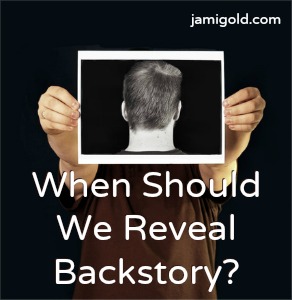
Several options. Dialog. Your double-major protagonist is reading a recently published and much discussed book on Covid and other variant viruses and another character shows up and says, “Good grief, Matt! I thought you swore you were never going to read another science book in your life.” And Matt’s response can tell the reader a bit depending on the reasons for reading it. If he is working on a task force to find out where another new virus came from, then he might say something along the lines of, “Yeah, I did say that, but those books were all about human bugs we had already conquered. And when I joined the FBI I had no plans to ever think about medicine again.” So, now you’ve told the reader he studied this in college, never planned a career in the field, as well as the career he did choose if the reader doesn’t already know that. But perhaps he’s FBI, but on a task force that has nothing to do with biology or the story. His reply might be something like, “I know, but Linda gave me this book and told me I just had to read it. So, I’m reading it.” The topic moves on, the reader knows he studied biology but it’s not critical now.
xx
 A similar way to inform the reader of the same information might be inside your character’s head. He’s digging frantically through this book, hoping to find a clue he never got from all the hundreds of books he had to read to pass his double major. Or, he’s listlessly turning pages hoping to find just enough fun facts to share with Linda so she doesn’t get pissed with him for not reading the book. This would also work with your firefighter who is slowly coming to and realizing something bad has happened. Memories of being so small he only took up half the gurney and being totally scared by all the strangers surrounding him. Only this time those strangers are anxiously working on him, monitors are beeping, everyone is intent on serious tasks, but the panic is the same. A similar way to inform the reader of the same information might be inside your character’s head. He’s digging frantically through this book, hoping to find a clue he never got from all the hundreds of books he had to read to pass his double major. Or, he’s listlessly turning pages hoping to find just enough fun facts to share with Linda so she doesn’t get pissed with him for not reading the book. This would also work with your firefighter who is slowly coming to and realizing something bad has happened. Memories of being so small he only took up half the gurney and being totally scared by all the strangers surrounding him. Only this time those strangers are anxiously working on him, monitors are beeping, everyone is intent on serious tasks, but the panic is the same.
xx
And then there’s action. Your character is involved with an activity they’ve done so many times they could do it in their sleep would give your reader a hint to your character’s back story, and this can segue into his conscious thoughts about what he’s doing, why he’s doing it and where  he learned how. What if your heroine is a nurse who has been doing rounds in a nursing home. When she comes to the old man’s bed he tries to reach out to her but his hand falls back to the sheet and his eyes seem to plead with her to understand he needs her. She’d seen that look before. When her grandfather had been failing but insisted on living out his days in his own home. Their family couldn’t afford round the clock nursing so they’d taken turns being with him. And it had been her turn the night he’d passed from this life to the next. He’d reached out to her just like that but his failing strength had caused him to miss the connection. She’d been younger then. She’d tried to guess what he needed. You need a drink. Her grandfather had shaken his head, a weak almost not there movement. She’d tried a bunch of other things. But every option she’d given him had been a similar no. So, she’d clutched at the weak, wrinkled hand, folding it into both her own with no idea what to do next. And her grandfather had sighed, his fingers trembling in hers and his mouth turned up in a small smile as he closed his eyes and his breathing faded away. All he’d needed was touch. The touch of another person in those last moments of life. So, now Jean reaches behind her and pulls a chair up to sink into as she lifts the man’s hand into her own and cradles it with warmth and caring. Now the reader knows important bits of her history as well as a lot about the kind of person she is. he learned how. What if your heroine is a nurse who has been doing rounds in a nursing home. When she comes to the old man’s bed he tries to reach out to her but his hand falls back to the sheet and his eyes seem to plead with her to understand he needs her. She’d seen that look before. When her grandfather had been failing but insisted on living out his days in his own home. Their family couldn’t afford round the clock nursing so they’d taken turns being with him. And it had been her turn the night he’d passed from this life to the next. He’d reached out to her just like that but his failing strength had caused him to miss the connection. She’d been younger then. She’d tried to guess what he needed. You need a drink. Her grandfather had shaken his head, a weak almost not there movement. She’d tried a bunch of other things. But every option she’d given him had been a similar no. So, she’d clutched at the weak, wrinkled hand, folding it into both her own with no idea what to do next. And her grandfather had sighed, his fingers trembling in hers and his mouth turned up in a small smile as he closed his eyes and his breathing faded away. All he’d needed was touch. The touch of another person in those last moments of life. So, now Jean reaches behind her and pulls a chair up to sink into as she lifts the man’s hand into her own and cradles it with warmth and caring. Now the reader knows important bits of her history as well as a lot about the kind of person she is.
xx
 There are other ways to introduce back story that are great but be careful not to overdo them. Unless you’re writing a memoir, you wouldn’t include pages from a diary or letters from the past more than a couple times in a book of fiction, but they can be a great way to tell an important story from the past that motivates the character now. There are other ways to introduce back story that are great but be careful not to overdo them. Unless you’re writing a memoir, you wouldn’t include pages from a diary or letters from the past more than a couple times in a book of fiction, but they can be a great way to tell an important story from the past that motivates the character now.
xx
A character’s reaction to something. Like seeing blue lights flashing behind him on the road. The average driver just pulls over and waits for the police car to pass. But what if your guy breaks out into a sweat. The last time he saw lights like that, it hadn’t ended well. Okay, here’ a bit of the character’s history that might need telling. Maybe in a flashback?
xx
 Dreams are another option for revealing backstory in the course of your novel. Or your heroine is having coffee with her friend and decides it’s time to tell the friend why she’d dropped out of high school before graduating. Getting pregnant had been a bombshell. Her religious belief precluded abortion. Her boyfriend turned his back on her. Her parents kicked her out of the house. So, she’d gone to live with an aunt in another state until her baby was born and put up for adoption. In the telling of this story, she can reveal not only to her friend, but to the reader, a huge chunk of her backstory that impacts the decisions she makes today. Dreams are another option for revealing backstory in the course of your novel. Or your heroine is having coffee with her friend and decides it’s time to tell the friend why she’d dropped out of high school before graduating. Getting pregnant had been a bombshell. Her religious belief precluded abortion. Her boyfriend turned his back on her. Her parents kicked her out of the house. So, she’d gone to live with an aunt in another state until her baby was born and put up for adoption. In the telling of this story, she can reveal not only to her friend, but to the reader, a huge chunk of her backstory that impacts the decisions she makes today.
xx
There are lots of ways to introduce backstory without dumping it all on the reader at the start of the story. It just takes a little patience to decide where and when. And never let it slow the current pacing of the story. One way to know if you’ve included all the important things or dumped too much after you’ve finished your first draft is to find a beta reader or three to just read. Not to critique the work, but just read and come back with comments, gut reactions, or questions. If you’re beta reader comes back with a question like, “I loved your hero Mikey, but  why on earth did he turn down that job offer?” Then you know there was backstory you were totally familiar with but failed to share in some way with the reader that was important to this decision. Another time the beta reader might suggest that the story is really confusing, or is so slow at the start that they wouldn’t have read it except they promised you they would. Now you have a hint in the first instance that there is some bit of history that needed telling that would have explained the confusing part and in the second instance, that you’ve dumped so much info at once that you dragged the action to a halt. Not every suggestion a beta reader offers needs to be incorporated but listen with an open mind. Sometimes we’ve been so close to the story as it unfolds we miss things someone with fresh eyes sees right off. While most authors are also readers, you are writing for readers so never discount what an ordinary reader might have to offer. They know what they like and enjoy and what turns them off. why on earth did he turn down that job offer?” Then you know there was backstory you were totally familiar with but failed to share in some way with the reader that was important to this decision. Another time the beta reader might suggest that the story is really confusing, or is so slow at the start that they wouldn’t have read it except they promised you they would. Now you have a hint in the first instance that there is some bit of history that needed telling that would have explained the confusing part and in the second instance, that you’ve dumped so much info at once that you dragged the action to a halt. Not every suggestion a beta reader offers needs to be incorporated but listen with an open mind. Sometimes we’ve been so close to the story as it unfolds we miss things someone with fresh eyes sees right off. While most authors are also readers, you are writing for readers so never discount what an ordinary reader might have to offer. They know what they like and enjoy and what turns them off.
xx
Thanks for taking the time to read my blog, and for a few other perspectives, visit my fellow Round Robin Blog Hoppers to see what they have to say about backstory.
xx

Connie Vines
A.J. Maguire
Dr. Bob Rich
Saturday, February 25 2023
 Our Round Robin Blog Hop this month asks the question: How can contemporary Fiction keep up with our swiftly changing world, politically, socially or technically? Or how do you keep your stories located in time? Our Round Robin Blog Hop this month asks the question: How can contemporary Fiction keep up with our swiftly changing world, politically, socially or technically? Or how do you keep your stories located in time?
XX
Sometimes, we are advised to keep our writing free of things that “date” it, and yet, this isn’t always either possible or desired. Unless you plan to never refer to any specific piece of popular music, a current TV show or movie, politician, movie star or sports hero, then you pretty much date your story with this information. Other things that can date a story that are easily overlooked are things like the mention of organic anything in the kitchen, security lines at the airport, reusable grocery bags and so much more.
XX
 Technology poses an even bigger challenge because it changes even more often than car models and fashion trends, so what is common today is gone tomorrow. I wrote a story set in 1972, not really that far in the past and yet when I depicted a harried father of an injured child asking my heroine to watch his other two kids because he was unable to reach his wife, my first beta reader asked why he didn’t just call her on her cell. I reminded my reader that cell phones did not exist in 1972. Yet, they have become so common, even for fairly young children, that not being able to reach someone is pretty much a thing of the past and even my savvy beta reader didn’t think about that. In my novel, it didn’t date the story so much as confuse the reader, but things like TVs with rabbit ears, VCRs and Game Boys do rather fix the time frame of the book. Technology poses an even bigger challenge because it changes even more often than car models and fashion trends, so what is common today is gone tomorrow. I wrote a story set in 1972, not really that far in the past and yet when I depicted a harried father of an injured child asking my heroine to watch his other two kids because he was unable to reach his wife, my first beta reader asked why he didn’t just call her on her cell. I reminded my reader that cell phones did not exist in 1972. Yet, they have become so common, even for fairly young children, that not being able to reach someone is pretty much a thing of the past and even my savvy beta reader didn’t think about that. In my novel, it didn’t date the story so much as confuse the reader, but things like TVs with rabbit ears, VCRs and Game Boys do rather fix the time frame of the book.
XX
 There are also the common reference points we have in our cultural memory. Suppose I mention that a town is like Mayberry, I’m betting there is a whole generation of young adult readers who have no idea where Mayberry is or what the reference suggests. God knows, even R2D2 or Rocky could be lost references. Says something about the permanence of Shakespeare that people still quote him. Watch an old movie or re-runs of old TV shows and note how many people smoke cigarettes. Old TV sitcoms always depicted married couples sleeping in twin beds. Not that many actually did use twin beds, but showing them sleeping together on TV was taboo. Future generations watching shows from as short a time as two years ago will wonder why there was no outward sign of the gay and lesbian lifestyle, or so few main characters of color that has suddenly appeared in just about every TV series’ casts today. There are also the common reference points we have in our cultural memory. Suppose I mention that a town is like Mayberry, I’m betting there is a whole generation of young adult readers who have no idea where Mayberry is or what the reference suggests. God knows, even R2D2 or Rocky could be lost references. Says something about the permanence of Shakespeare that people still quote him. Watch an old movie or re-runs of old TV shows and note how many people smoke cigarettes. Old TV sitcoms always depicted married couples sleeping in twin beds. Not that many actually did use twin beds, but showing them sleeping together on TV was taboo. Future generations watching shows from as short a time as two years ago will wonder why there was no outward sign of the gay and lesbian lifestyle, or so few main characters of color that has suddenly appeared in just about every TV series’ casts today.
XX
 Bottom line for me is that there is no way to avoid any hint of a general time frame in our writing. Unless you are writing Sci-fi or historical, there has to be a backdrop that makes the characters and story come alive and to avoid any specifics is to leave the page and the characters colorless. Sometimes you can re-write a scene to avoid a problem. In my example above, I removed the distraught father’s comment about not knowing where his wife was and replaced it with she was out running errands and “Taking this gang to the ER with me would be a nightmare.” So I avoided the confusing reference. There are a number of ways to avoid a time tagging reference. For instance, instead of having your character watch Gunsmoke or CSI, you could simply say they fixed a bowl of popcorn and plopped into their recliner to watch their favorite TV series. Bottom line for me is that there is no way to avoid any hint of a general time frame in our writing. Unless you are writing Sci-fi or historical, there has to be a backdrop that makes the characters and story come alive and to avoid any specifics is to leave the page and the characters colorless. Sometimes you can re-write a scene to avoid a problem. In my example above, I removed the distraught father’s comment about not knowing where his wife was and replaced it with she was out running errands and “Taking this gang to the ER with me would be a nightmare.” So I avoided the confusing reference. There are a number of ways to avoid a time tagging reference. For instance, instead of having your character watch Gunsmoke or CSI, you could simply say they fixed a bowl of popcorn and plopped into their recliner to watch their favorite TV series.
XX
But there will be times you can’t avoid or work around these issues. My advice is just write the best story ever and it won’t matter that it’s dated. 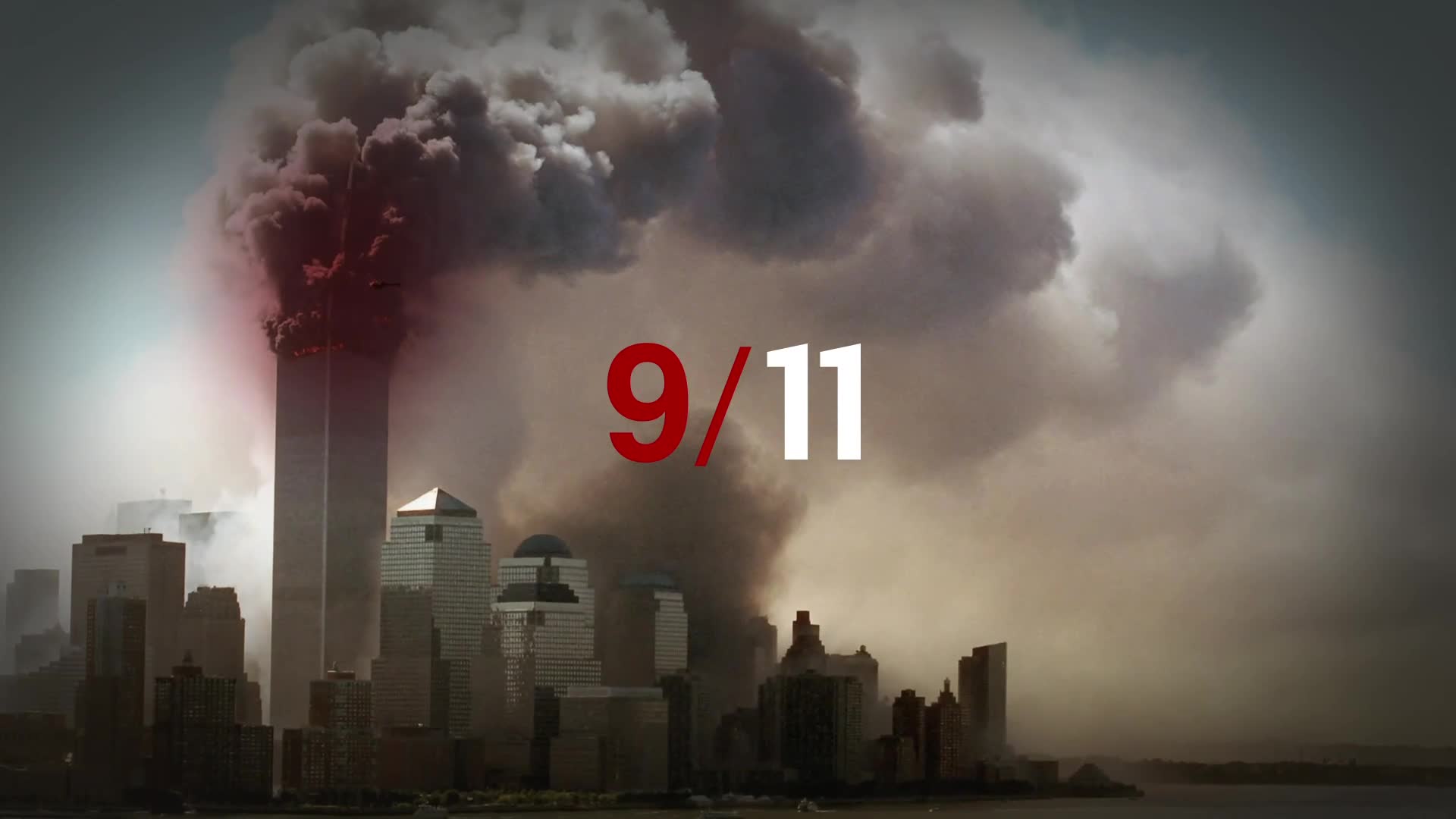 Depending on the story, you might want to find a way to tell the reader where they are and when. Easily done with a date line at the beginning of the book, or each chapter if the story moves from one time period to another. Or set the scene in the first few pages of the book with easily identifiable references. Examples might be: ‘It had only been a few years since 9/11 and people Depending on the story, you might want to find a way to tell the reader where they are and when. Easily done with a date line at the beginning of the book, or each chapter if the story moves from one time period to another. Or set the scene in the first few pages of the book with easily identifiable references. Examples might be: ‘It had only been a few years since 9/11 and people 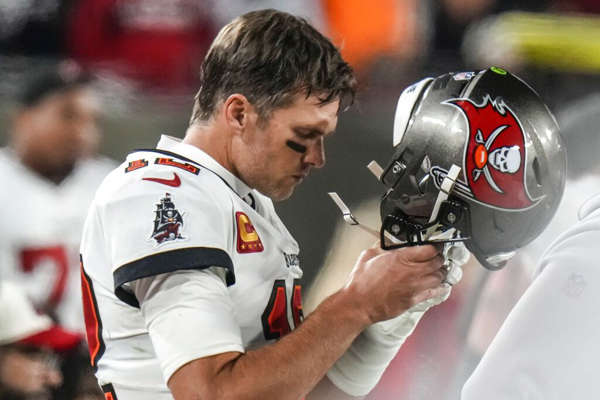 hadn’t begun to whine about long lines at the airport, yet.’ or ‘Tom Brady had finally retired, for good, and now NFL fans would have to find someone else to adore or hate.’ Even kids born since 9/11 know what that ominous number means. Not everyone is a football fan but pretty much everyone’s heard of Tom Brady and his climb to fame as the GOAT. hadn’t begun to whine about long lines at the airport, yet.’ or ‘Tom Brady had finally retired, for good, and now NFL fans would have to find someone else to adore or hate.’ Even kids born since 9/11 know what that ominous number means. Not everyone is a football fan but pretty much everyone’s heard of Tom Brady and his climb to fame as the GOAT.
XX
So, that’s my take on dating your stories. The era is part of the story, adds color and explanation to the actions of the characters and maybe we shouldn’t work so hard to avoid it. But why not hop on over and see how these other authors view the question.
XX
Victoria Chatham
Connie Vines
Dr. Bob Rich
Anne Stenhouse
Helena Fairfax
Saturday, January 21 2023
 It's a new year so, first off, Happy New Year and best wishes for 2023. And our Blog Hop topic is ... New Beginnings! Appropriate, right? As a writer, how do you motivate yourself to get back to writing when life has interrupted your flow and/or, how do you begin a new writing challenge? It's a new year so, first off, Happy New Year and best wishes for 2023. And our Blog Hop topic is ... New Beginnings! Appropriate, right? As a writer, how do you motivate yourself to get back to writing when life has interrupted your flow and/or, how do you begin a new writing challenge?
XX
 At the moment, I’m asking myself that very question…How to get back in the groove? It’s been a couple months since I’ve done any constructive work on any of the three books currently in progress. First it was a medical issue, then it was shopping for a series of birthdays with Christmas right on the heels of that and finally travel to be with family over Christmas. So, here I am, at the start of a new year, getting back into the groove and I’m betting I’m not alone. At the moment, I’m asking myself that very question…How to get back in the groove? It’s been a couple months since I’ve done any constructive work on any of the three books currently in progress. First it was a medical issue, then it was shopping for a series of birthdays with Christmas right on the heels of that and finally travel to be with family over Christmas. So, here I am, at the start of a new year, getting back into the groove and I’m betting I’m not alone.
XX
 Years ago, a well-known, award-winning, best-selling author was the keynote speaker of a conference I’d decided to attend. She began her talk with an anecdote about her writing life. She’d been in a rut and told her husband she was having trouble concentrating because of no private writing space. She had three kids and a household to run so sitting down at the table where she had been working had become too much of a distraction. Hubby responded by renovating the space over their garage, creating a wonderful new office, Years ago, a well-known, award-winning, best-selling author was the keynote speaker of a conference I’d decided to attend. She began her talk with an anecdote about her writing life. She’d been in a rut and told her husband she was having trouble concentrating because of no private writing space. She had three kids and a household to run so sitting down at the table where she had been working had become too much of a distraction. Hubby responded by renovating the space over their garage, creating a wonderful new office, 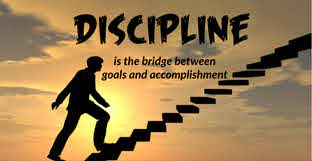 comfortable and private. Space to warm any writer’s heart. As she told the story, on her first day in this awesome new writer’s paradise, she booted up her computer and opened her document. Then checked her email. Looked at her manuscript, then played a game of solitaire or twelve. Back to looking at the book in process, then another game of solitaire or twelve and another quick check of email. Laughing at herself, she summarized this by saying, it’s a matter of discipline, not place, time, opportunity or even inspiration. But just sheer discipline. comfortable and private. Space to warm any writer’s heart. As she told the story, on her first day in this awesome new writer’s paradise, she booted up her computer and opened her document. Then checked her email. Looked at her manuscript, then played a game of solitaire or twelve. Back to looking at the book in process, then another game of solitaire or twelve and another quick check of email. Laughing at herself, she summarized this by saying, it’s a matter of discipline, not place, time, opportunity or even inspiration. But just sheer discipline.
XX
 That was years ago and now our computers offer us a zillion times more distractions from social media, email, online shopping and games of all kinds. Discipline has become even more important. Bottom line, put the butt in the chair and just “get it done” as the Nike folk say. To that end, there are several technical answers: turn off the internet being one key option. You could always delete all the apps and bookmarks to remove temptation, if disconnecting from the internet seems extreme. But bottom line, it still comes back to discipline. That was years ago and now our computers offer us a zillion times more distractions from social media, email, online shopping and games of all kinds. Discipline has become even more important. Bottom line, put the butt in the chair and just “get it done” as the Nike folk say. To that end, there are several technical answers: turn off the internet being one key option. You could always delete all the apps and bookmarks to remove temptation, if disconnecting from the internet seems extreme. But bottom line, it still comes back to discipline.
XX
 One thing I’ve found in the past is overestimating myself. I was hot – like on fire hot – when I was finishing up my last project. A thousand words, two thousand words or more a day just poured out without half trying, and it didn’t matter when I sat down to write. It was like having a tiger by the tale and all I had to do was hang on for the ride. But if things have stalled, this isn’t happening. You sit down to write and the words are hard to find. It can be discouraging to plug away and come up with far less than you had planned. All very discouraging. When this happens to me, I find setting a far more modest goal helps. We all know that positive reinforcement is encouraging so instead of expecting myself to write a thousand new words, I cut it in half. Or even in quarters. Telling yourself you’re just going to get 200 new words today sounds like a very doable task and it’s amazing how satisfying it feels to get that 200. Going way over that modest goal? AWESOME! One thing I’ve found in the past is overestimating myself. I was hot – like on fire hot – when I was finishing up my last project. A thousand words, two thousand words or more a day just poured out without half trying, and it didn’t matter when I sat down to write. It was like having a tiger by the tale and all I had to do was hang on for the ride. But if things have stalled, this isn’t happening. You sit down to write and the words are hard to find. It can be discouraging to plug away and come up with far less than you had planned. All very discouraging. When this happens to me, I find setting a far more modest goal helps. We all know that positive reinforcement is encouraging so instead of expecting myself to write a thousand new words, I cut it in half. Or even in quarters. Telling yourself you’re just going to get 200 new words today sounds like a very doable task and it’s amazing how satisfying it feels to get that 200. Going way over that modest goal? AWESOME!
XX
 Another thing to consider is timing. When is your best time to write? When are you most productive? Or, in some cases, when can you realistically expect to have an hour or even just a half hour you can focus solely on the writing. Assess your day, your other commitments, and your writing style and deliberately set aside that hour (more or less) for nothing BUT writing. Exceptions do have to be made from time to time, for various reasons, but don’t let those exceptions become the rule. Stick to your set time, put your butt in the chair, turn off the internet and start writing. Another thing to consider is timing. When is your best time to write? When are you most productive? Or, in some cases, when can you realistically expect to have an hour or even just a half hour you can focus solely on the writing. Assess your day, your other commitments, and your writing style and deliberately set aside that hour (more or less) for nothing BUT writing. Exceptions do have to be made from time to time, for various reasons, but don’t let those exceptions become the rule. Stick to your set time, put your butt in the chair, turn off the internet and start writing.
XX
 Another writer friend of mine used to do a workshop she called “You can’t edit nothing.” Sometimes we get so caught up in our words being perfect, we end up writing nothing new. We keep going over what we have and tweaking. We are so concerned about being perfect, we end up writing nothing. But, as my friend says, you can’t edit nothing – so just write. Don’t worry about perfection, coherence, repetitive stuff, or even things like character development and plot. Just write. Let the words flow. You can edit later. Another writer friend of mine used to do a workshop she called “You can’t edit nothing.” Sometimes we get so caught up in our words being perfect, we end up writing nothing new. We keep going over what we have and tweaking. We are so concerned about being perfect, we end up writing nothing. But, as my friend says, you can’t edit nothing – so just write. Don’t worry about perfection, coherence, repetitive stuff, or even things like character development and plot. Just write. Let the words flow. You can edit later.
XX
 Besides the mechanics of writing, there is also the enthusiasm - enjoying what you are doing. Sometimes we lose that and finding it again can be even more elusive. There are a few ways I find to overcome this. For me, one helper when I’m part way into a project, is to send the partial manuscript to my Kindle. Then I fix myself a cup or tea, get comfy and just start reading. When I read all the way to where I stalled I always discover a half a dozen new ideas scrambling in my head to get added to the story. Besides the mechanics of writing, there is also the enthusiasm - enjoying what you are doing. Sometimes we lose that and finding it again can be even more elusive. There are a few ways I find to overcome this. For me, one helper when I’m part way into a project, is to send the partial manuscript to my Kindle. Then I fix myself a cup or tea, get comfy and just start reading. When I read all the way to where I stalled I always discover a half a dozen new ideas scrambling in my head to get added to the story.
XX
 Another option is to discuss my story, or the problem I’m having with a willing friend. That friend doesn’t have to be a writer so long as they are willing to listen. In telling it to someone else I catch the excitement again and often, in telling it out loud, discover the problem that was keeping me from moving forward. And as a bonus, the friend often has ideas to add to my thoughts. Another option is to discuss my story, or the problem I’m having with a willing friend. That friend doesn’t have to be a writer so long as they are willing to listen. In telling it to someone else I catch the excitement again and often, in telling it out loud, discover the problem that was keeping me from moving forward. And as a bonus, the friend often has ideas to add to my thoughts.
XX
 And then there is brainstorming with my critique partner or group of writer friends. For me, it’s a four-writer group we named the Sandy Scribblers and we meet once a month. Used to be face to face in a library, but due to Covid turned into a Zoom meeting (which has the advantage of not having to go anywhere, get comfy in your own chair, have a snack or wear your Pjs.) Bouncing my stalled plot against this group is a sure-fire way to get going again. We are a very mixed group in what we write and the ideas and comments come from everywhere. Not that I end up using all the possibilities, but this kind of give and take gets the creative juices fired up. And then there is brainstorming with my critique partner or group of writer friends. For me, it’s a four-writer group we named the Sandy Scribblers and we meet once a month. Used to be face to face in a library, but due to Covid turned into a Zoom meeting (which has the advantage of not having to go anywhere, get comfy in your own chair, have a snack or wear your Pjs.) Bouncing my stalled plot against this group is a sure-fire way to get going again. We are a very mixed group in what we write and the ideas and comments come from everywhere. Not that I end up using all the possibilities, but this kind of give and take gets the creative juices fired up.
XX
 If, after trying all these avenues, my brain is still stuck, my best advice is to put that manuscript to bed, at least for a while. Try something totally different. I often have some notes I scribbled at some point about an idea I had while I were busy with another book. I dig them out and take them for a walk. A physical walk. I read my scribbled thoughts, then go for a walk and let the ideas bob around in my brain. Sometimes whole scenes will crowd into my head and I can’t wait to get home and get them typed up before I forget them. I can backtrack and do character studies and plotting later, once I’m fired up about this new project. You might have a book you wrote that was intended as a one-off but readers have asked if there will be a sequel. Think about If, after trying all these avenues, my brain is still stuck, my best advice is to put that manuscript to bed, at least for a while. Try something totally different. I often have some notes I scribbled at some point about an idea I had while I were busy with another book. I dig them out and take them for a walk. A physical walk. I read my scribbled thoughts, then go for a walk and let the ideas bob around in my brain. Sometimes whole scenes will crowd into my head and I can’t wait to get home and get them typed up before I forget them. I can backtrack and do character studies and plotting later, once I’m fired up about this new project. You might have a book you wrote that was intended as a one-off but readers have asked if there will be a sequel. Think about  it. Is there anywhere a sequel can go? Are there characters you could bring to the front of a follow-on? it. Is there anywhere a sequel can go? Are there characters you could bring to the front of a follow-on?
XX
Last, but definitely not least, sign up for a workshop or a conference. Go to a regular local writer’s meeting and take notes as the speaker digs into the topic of the day. I guarantee you will come home energized with ideas and a desire to get that butt into the chair and start writing again, whether it was the project you stalled out on or something entirely new.
XX
 Now you can hop on over and check out the rest of the Blog Hopping Crew for hints on how to get moving again: (Thanks to Marci Baun for our new logo.) Now you can hop on over and check out the rest of the Blog Hopping Crew for hints on how to get moving again: (Thanks to Marci Baun for our new logo.)
Dr. Bob Rich
Anne Graham
Connie Vines
Diane Bator
A.J. Maguire
Victoria Chatham
Fiona McGier
Marci Baun
Saturday, October 22 2022
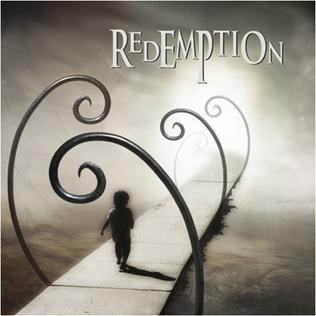 Our Round Robin Blog Hop is celebrating, if that’s the right word, its one hundredth posting with a really challenging subject: Have any of your villainous characters reached redemption for their actions? If you were going to do this (or have done it), how would (did) you go about it? Our Round Robin Blog Hop is celebrating, if that’s the right word, its one hundredth posting with a really challenging subject: Have any of your villainous characters reached redemption for their actions? If you were going to do this (or have done it), how would (did) you go about it?
XX
 My first reaction to this topic was, “I don’t have any villains I want to or have redeemed.” Mostly because the stories I’ve written have heroes and heroines who are struggling to conquer their personal demons rather than fighting the “bad guy” or some other villainous entity. But as I was getting ready to bow out, I realized I am currently in the final edits for a book with a character who actually was the source of my hero’s problems and, the reason my hero spent a year in prison for a crime he did not commit. My first reaction to this topic was, “I don’t have any villains I want to or have redeemed.” Mostly because the stories I’ve written have heroes and heroines who are struggling to conquer their personal demons rather than fighting the “bad guy” or some other villainous entity. But as I was getting ready to bow out, I realized I am currently in the final edits for a book with a character who actually was the source of my hero’s problems and, the reason my hero spent a year in prison for a crime he did not commit.
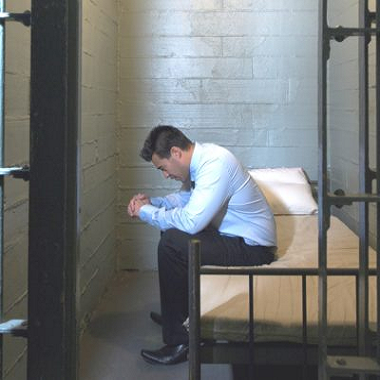 XX XX
As I thought about this character, Gino Rossi, I realized there were reasons I might want to find a way to redeem him going forward. Although this book ends with him taking the fall for the crimes he committed and managed to get blamed on my hero, that might not have to be the end of his story.
XX
 Why would I want to redeem him, you ask? He got Mac convicted of a crime he didn’t commit, got him tossed from the job he loved and ruined his reputation. So why would I want to redeem Gino? Well, for most of this book, Mac considers Gino to be his friend. They grew up together, learned to fly and shared a passion for the job they both loved piloting sight-seeing tours over their scenic shoreline and historic home-town. Mac is seriously saddened to discover his friend’s connection to his own troubles. Why would I want to redeem him, you ask? He got Mac convicted of a crime he didn’t commit, got him tossed from the job he loved and ruined his reputation. So why would I want to redeem Gino? Well, for most of this book, Mac considers Gino to be his friend. They grew up together, learned to fly and shared a passion for the job they both loved piloting sight-seeing tours over their scenic shoreline and historic home-town. Mac is seriously saddened to discover his friend’s connection to his own troubles.
XX
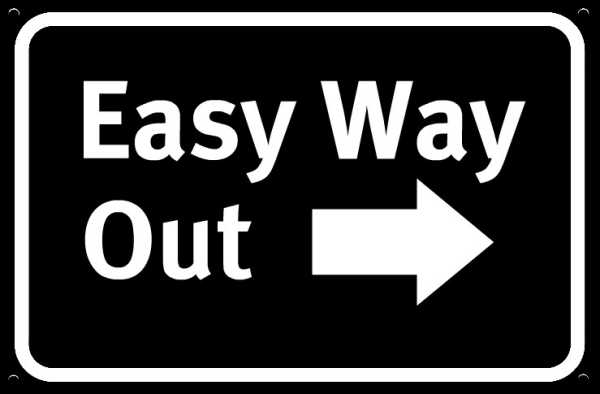 So who is Gino Rossi? He’s not an evil psychopath. He isn’t into hurting people or killing animals. He isn’t willing to do whatever it takes to get to the top no matter who gets squashed along the way. He just isn’t your average villain everyone expects to hate. My hero still sees the good in him even after the role Gino played in Mac’s troubles is finally revealed; even after a very desperate Gino tries to cause Mac’s plane to crash. So who is Gino Rossi? He’s not an evil psychopath. He isn’t into hurting people or killing animals. He isn’t willing to do whatever it takes to get to the top no matter who gets squashed along the way. He just isn’t your average villain everyone expects to hate. My hero still sees the good in him even after the role Gino played in Mac’s troubles is finally revealed; even after a very desperate Gino tries to cause Mac’s plane to crash.
XX
With that in mind, how would I rehabilitate Gino? I’m currently working on the next book in this series and this topic has given me a whole new avenue of possibilities to explore in that plot. While Mac is no longer the main character, he’s still on the  scene along with another newer friend who is the hero of this next book. Lucas Trevlyn had been a decent kid and a good soldier who’d gone astray after returning from war, gotten into trouble and ended up doing time. Lucas felt like he had nothing left to live for and was ready to end his life when an off-duty cop happened along and talked him out of it. This cop helped Lucas see a future for himself, believed in him and encouraged him to believe in himself, and Lucas got his life squared away. Now he’s the manager of a second chance house for men who are where he once was. Basically decent guys who managed to find themselves on the wrong side of the law due to a variety of poor choices and mistakes who are now trying to put their lives back together. scene along with another newer friend who is the hero of this next book. Lucas Trevlyn had been a decent kid and a good soldier who’d gone astray after returning from war, gotten into trouble and ended up doing time. Lucas felt like he had nothing left to live for and was ready to end his life when an off-duty cop happened along and talked him out of it. This cop helped Lucas see a future for himself, believed in him and encouraged him to believe in himself, and Lucas got his life squared away. Now he’s the manager of a second chance house for men who are where he once was. Basically decent guys who managed to find themselves on the wrong side of the law due to a variety of poor choices and mistakes who are now trying to put their lives back together.
XX
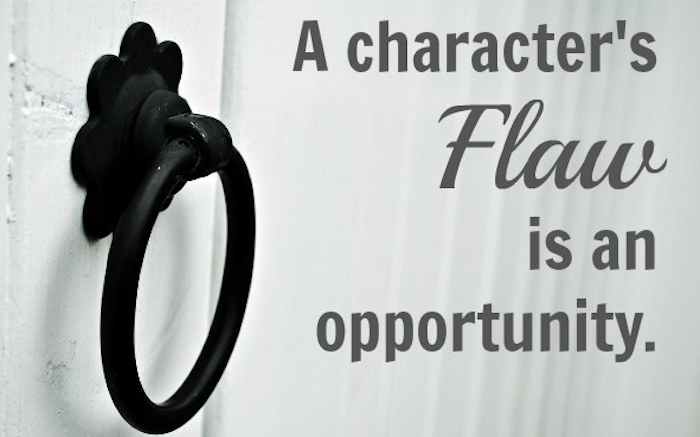 Now I ask myself, ‘what if Mac and Lucas, together were able to convince Gino he was worth both their friendship and a second chance to get his life right?’ While not being a determined villain, Gino has always taken the easy way out of situations and up to now, never owned up to his own failings. Willing to sacrifice his only friend to save himself from a morass of his own making, Gino isn’t a very heroic or likeable character. Are these character flaws that can’t be redeemed? I’m convinced it would be an interesting challenge to see if I can turn Gino from an unfortunate, misdirected character into someone my readers would want to cheer for. Now I ask myself, ‘what if Mac and Lucas, together were able to convince Gino he was worth both their friendship and a second chance to get his life right?’ While not being a determined villain, Gino has always taken the easy way out of situations and up to now, never owned up to his own failings. Willing to sacrifice his only friend to save himself from a morass of his own making, Gino isn’t a very heroic or likeable character. Are these character flaws that can’t be redeemed? I’m convinced it would be an interesting challenge to see if I can turn Gino from an unfortunate, misdirected character into someone my readers would want to cheer for.
XX
Like any other failing in human nature, Gino will have to want to change. He’ll have to sink pretty low and realize change is his only  option. Mac and Lucas can be there to help, but Gino is going to have to do the heavy lifting to make himself into a hero any reader can want to follow and celebrate his success. Since, until this blog post, this was never a book I had intended to write, I don’t know if or how Gino might redeem himself, but I’m certainly going to enjoy finding out and look forward to the challenge. option. Mac and Lucas can be there to help, but Gino is going to have to do the heavy lifting to make himself into a hero any reader can want to follow and celebrate his success. Since, until this blog post, this was never a book I had intended to write, I don’t know if or how Gino might redeem himself, but I’m certainly going to enjoy finding out and look forward to the challenge.
XX
Want to see how some of my fellow blog hoppers have redeemed some of their characters? Check them out at:

Diane Bator
Judith Copek
Connie Vines
A.J. Maguire
Dr. Bob Rich
Robin Courtright
|